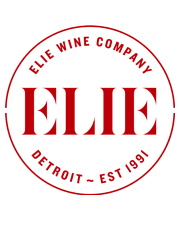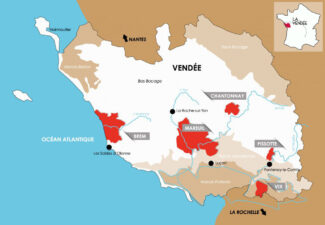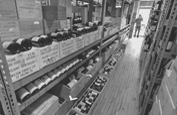Enthroned At The Summit Of Larzac: Domaine de Montcalmès, A Languedoc Stand-out, Drinks Well In Its Youth And Shows No Weakness With Age + Recent Arrival Two Rising Stars From Larzac — Five-Bottle Package For $215
If you’re an aspiring domaine owner working with a tight budget, and have an eye to producing world-class French wine, you could do worse than Terrasses du Larzac, where an acre of vineyard land might set you back the equivalent of $5,000. Compare that to Burgundy’s $100,000-an-acre mind-blowing average. Not only that, but only 35% of the available land is currently under vine.
It’s no wonder that this relatively new (2014) appellation is seducing many winemakers who are equally green behind the ears; they are beginning careers with an eye (and palate) toward quality—still a rather novel concept in Languedoc, long the home for a sea of cheap wine available for under ten dollars a bottle. AOP rules in TdL are relatively tight in comparison to the Languedoc as a VdF: in Larzac, there are five permitted grapes—Grenache, Syrah, Mourvèdre, Cinsault and Carignan; the wines must be blends and include at least two from Grenache, Syrah and Mourvèdre. Furthermore, cellar-ageing must last at least one year.
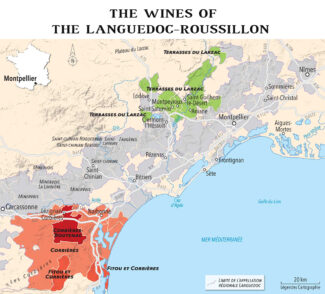
Among the new class of Larzac producers, we number the following as among our favorites. They are visionaries with both heritage and discipline, finding in the wonderfully diverse terroirs of the region an opportunity to rival, and frequently outgun, wines from the same grapes made way up north in the Rhône.
Terrasses du Larzac: A Languedoc Stand-Out, Coming Into Its Own
The history of Languedoc’s vineyards dates back to the 5th century BCE when the Greeks introduced vines to the area. As such, the Terrasses du Larzac AOP is a bit anomalous simply because it only received official recognition in 2014. Extending across 32 communes among the foothills of Larzac, with its northern boundary naturally formed by the Causse du Larzac, part of TdL’s appellation upgrade was a phasing-out of the predominantly Carignan-based wines of the past in favor of ‘cépages améliorateurs’ (improver varieties) like Grenache, Syrah and Mourvèdre—grapes more usually associated with Rhône. Carignan is now limited to only 30% of any Terraces du Larzac wine.

But the terroir is perfectly suited to the Big Three; Larzac is geologically varied and offers soils that range from stony clay and sand, iron-rich red soils, and heavier clay soils with high limestone content. Vineyards situated on the banks of the Hérault river are planted on pebble-strewn alluvial terraces and stonier soils with limestone bedrock. The average altitude of the local vineyards is around 400 feet, but rise to nearly 1300 feet in the northerly commune of Saint Privat. The Mediterranean climate provides distinctly seasonal rainfall throughout spring and fall, and thanks to the nearby mountains of the southern Massif Central, the appellation’s vineyards enjoy the benefits of cooler nights after hot days, helping to provide balance between sugar and acid in the grapes.
The Package …
This week’s package offering is comprised of five wines featured and numbered below: Two wines from Montcalmès, one red and one white, and one of each of Saint-Sylvester and Le Clos du Serres two wines for a total of five bottles at $215.
Domaine de Montcalmès
The Summit of Larzac
The quiet persistence of Frédéric Pourtalié has, since his first vintage in 1999, gradually elevated Domaine de Montcalmès to a quality level to match his mentor Grange de Pères, although in terms of cult wine status, it still flies a bit under the radar. Pourtalié trained at Pères before taking over family vineyards at the edge of the Massif Central, where cool night air descends off the Cévennes Mountains.
Named for a hamlet that once overlooked the Hérault valley, Pourtalié’s winemaking cousin Vincent Guizard (now of Domaine Saint-Sylvestre) joined in 2003 in a quest to put the Hérault estate on the world’s wine map. Today, Pourtalié farms 54 acres spread between the communes of Puéchabon, Aniane, St. Jean de Fos and St. Saturnin de Lucian, each with its own unique microclimate and soil geology. Montcalmès means ‘limestone mountain’ in Occitan, and Pourtalié draws variously from the lacustrine limestones of Puéchabon, the rolled pebbles of Aniane, the scree of Saint-Saturnin and the clays of Saint-Jean-de-Fos.

Frédéric Pourtalié, Domaine de Montcalmès
photo: Atelier Soubiran
The domain is hundreds of miles from either Burgundy or Southern Rhône, but the influence of both manages to trickle down to Pourtalié’s operation. His Mourvèdre grows on pudding-stones nearly identical to Châteauneuf-du-Pape’s galets roulés and his red wines are aged for 24 months in old Romanée-Conti barrels, giving them a potential longevity of a decade or more.
Frédéric Pourtalié proudly shares that for the past decade, he has been supplying top-end wines to local Michelin starred restaurants— the Pourcel, the Auberge du Vieux Puits in Fontjoncouse, Michel Bras in Aveyron—but also the Troisgros, Pierre Gagnaire, the Grillon in Paris. “Between restaurants and a network of wine merchants, it is sometimes hard to keep up,” says Pourtalié.
“We are slowly expanding; I recently planted six acres of Syrah on a clearing of scrubland on the hillsides, but I’ve also made time to vinify a 100% Viognier in Vin de France, this time sold only in the cellar. A special vintage just for visitors.”
Vintage 2020
The ‘nutshell’ summation of the 2020 vintage in Languedoc is ‘low quantity, high quality.’
For the most part, the appellation had ample reserves of water from flooding the previous autumn and winter. The spring was quite cool, and there was quite a bit of rainfall in late April early May. Summer heated up, but not to the over-the-top extremes of 2019; it was dry, but the August nights were cool—ideal were quite warm but thankfully without the extremes of 2019. High summer did of course warm up and was dry as usual, but the August nights were cool with an ideal condition for the ripening and flavor development.
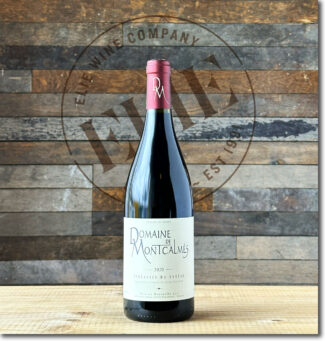 •1• Domaine de Montcalmès, 2020 Terrasses du Larzac ($57) – One Bottle
•1• Domaine de Montcalmès, 2020 Terrasses du Larzac ($57) – One Bottle
60% Syrah, 20% Mourvèdre, 20% Grenache; the grapes were destemmed and crushed and allowed to ferment separately on indigenous yeast during a maceration of 30 days. The varieties underwent regular punching down, following which barrel-aging took place over 24 months; the three varieties were blended two months before bottling.
The wine shows clean blackberry and cassis notes while the palate is silky with spice and fine-grained leather with a touch of licorice on the finish.
 Domaine de Montcalmès, 2020 Languedoc Blanc ($58)
Domaine de Montcalmès, 2020 Languedoc Blanc ($58)
50% Marsanne, 50% Roussanne—the classic Hermitage blend in which the Marsanne provides body and the delicate flavors of peach, pear and spice, while Roussanne brings elegance, aroma, crisp acidity for aging and nut along with mineral notes. The vines, now over twenty years old, are located in Puéchabon on a clay-limestone hillside. After harvesting by hand, the two varietals were pressed and vinified together via direct pressing, and cold settled. Vinification occurred on indigenous yeasts in barrels and demi-muids and the wine was aged in used oak barrels for 24 months. The different barrels were blended 4 to 6 months before bottling.
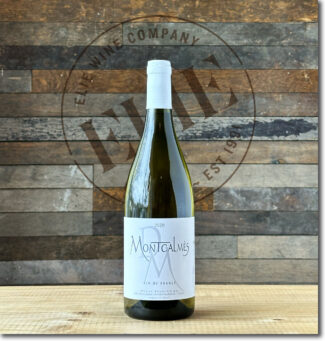 •2• Domaine de Montcalmès, 2020 VdF Languedoc-Terrasses du Larzac Blanc ($47) – One Bottle
•2• Domaine de Montcalmès, 2020 VdF Languedoc-Terrasses du Larzac Blanc ($47) – One Bottle
40% Petit Manseng, 10% Gros Manseng, 10% Petit Courbu, 10% Gros Courbu, 15% Chenin, 15% Chardonnay; a blend so unusual it wears the generic VdF label, but don’t let that fool you; the wine is a gem, showing taut minerality and an herbal edge suggestive of the wild thyme and fennel that grow near the vines. In the mouth, it is reminiscent of honey, almonds, wildflowers and gentle brine.
Vintage 2019
2019 was (as is happening more and more frequently) a season of intense drought, beginning with a cold, dry spring which slowed leaf development in the vines. High summer temperatures arrived quickly and further slowed growth during peaks. Relief came in the weeks before harvest with a mercury drop, especially at night, and a few rain-filled days. Harvest 2019 came later than in 2018 and the wines are more concentrated, with nicely defined tannins behind moderate to low acidity.
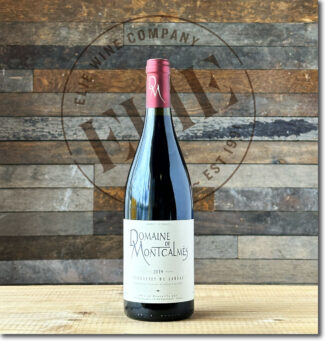 Domaine de Montcalmès, 2019 Terrasses du Larzac ($57)
Domaine de Montcalmès, 2019 Terrasses du Larzac ($57)
60% Syrah, 20% Mourvèdre, 20% Grenache. The two sites that contribute to this are distinct; the first is north-facing and on limestone scree, the source of the Syrah and Grenache, while the second is south-facing and on galet roulés as you might find in Châteauneuf-du-Pape. This warmer site is where he sources the heat-loving Mourvèdre. The wine aged in old casks from Domaine de la Romanée-Conti for two years before release and reamins fresh on the nose with ripe plum and blackberry, bricking out with leather, balsamic, undergrowth, chocolate and dried fruit.
Vintage 2015
A delightful vintage for Languedoc; one that wine writer Jancis Robinson calls ‘une année vinabilis.’ Water tables were replenished over the previous year’s winter, and spring was warm and dry, with no weather issues during flowering. Conditions that favor healthy and clean fruit continued into summer, with no hail or rainstorms of any serious note. Hydric stress was an issue for younger vines with shallower roots, notably some Syrah planted in 2006. The older Grenache and Syrah shrugged it off as deeper roots found water. Harvesting began in early September and finished a week earlier than ever before. Grenache wound up as the star of the year; ripe, healthy and very juicy. The Syrah yielded smaller but very concentrated and fruity berries. The Mourvèdre and Carignan were well-balanced between acid and sugar.
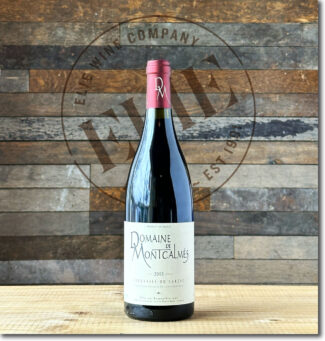 Domaine de Montcalmès, 2015 Terrasses du Larzac ($48)
Domaine de Montcalmès, 2015 Terrasses du Larzac ($48)
60% Syrah, 20% Mourvèdre, 20% Grenache; an enticing nose displaying ripe black cherry, anise and a fleeting whiff of dried strawberry. A Grenache with a delicacy that is reminiscent of Château-Rayas; a nice balance between fruit and the grip of acidity and silken tannins.
Vintage 2014
As folks in Languedoc recall too well, 2014 was the vintage of cataclysmic hailstorms which seriously compromised yields. Spells of unseasonably hot spring weather tested vines while the summer brought sharp variations in temperature, with cool periods followed by periods of extreme heat. Only the most careful and persistent vintners produced notable wines, but the best of these show balance, concentration and complexity at relatively low alcohol levels.
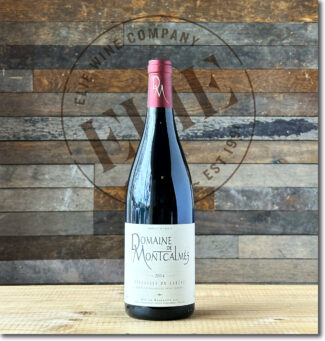 Domaine de Montcalmès, 2014 Terrasses du Larzac ($50)
Domaine de Montcalmès, 2014 Terrasses du Larzac ($50)
60% Syrah, 20% Mourvèdre, 20% Grenache; the nose is full of leathery cherry and perfumed with dried violet while the fruit is settling into garrigue spice with a long and lingering finish washed in velvety tannins.
Vintage 2013
Compared with the rest of France, the Languedoc fared well in 2013, escaping most of the major climatic hazards that beset other regions. Key climatic factors were a wet spring—the wettest in thirty years—but that meant that there was no danger of water stress later in the season. Summer arrived late, leading to a late harvest—sometimes grapes catch up, but this year they did not. Fortunately, September was bright and sunny and the rain that did fall did not harm the grapes. They ripened well, with supple tannins and ample freshness.
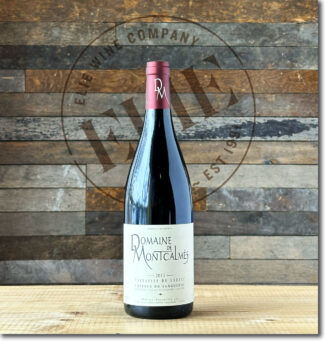 Domaine de Montcalmès, 2013 Terrasses du Larzac ($49)
Domaine de Montcalmès, 2013 Terrasses du Larzac ($49)
60% Syrah, 20% Mourvèdre, 20% Grenache; a typically elegant wine in the process of aging beautifully, showing broad and expansive dried berries and kirsch accented by hints of garrigue and Asian spice. The finish is very long, with ripe, silky, fine-grained tannins.
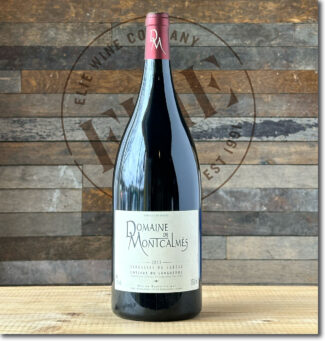 Domaine de Montcalmès, 2013 Terrasses du Larzac ($130) Magnum
Domaine de Montcalmès, 2013 Terrasses du Larzac ($130) Magnum
A large format version of the above.
Vintage 2012
The most challenging vintage Languedoc had seen in 22 years. Yields were low thanks to drought at one stage and mildew at another, and late, uneven ripening resulted in many wines without fully-developed character. It was not a complete disaster, however, and top domains were able to produce a limited amount of excellent wine.
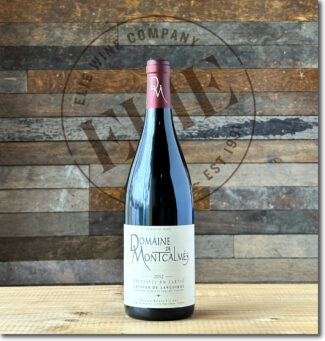 Domaine de Montcalmès, 2012 Terrasses du Larzac ($47)
Domaine de Montcalmès, 2012 Terrasses du Larzac ($47)
60% Syrah, 20% Mourvèdre, 20% Grenache. Polished and splendidly bricked-out, this elegant wine offers dark fruits, bittersweet chocolate and light notes of vanilla behind musk and five-spice powder.
RECENT ARRIVAL
Domaine Saint Sylvestre
Terrasses du Larzac, Languedoc
It’s easy to conclude that Terrasses du Larzac has one of the highest concentrations of ambitious young producers in the south of France. This is partially due to the unique climate conditions but also the vast range of soil types confined to a relatively small area. Throughout the communes that host Larzac’s vineyards, you’ll encounter schist, sand, horizontal layers of red ruffe, clay/limestone and galets roulés in the course of a few miles.
“Among the more interesting of these types is the ruffe,” says Vincent Guizard of Domaine Saint-Sylvestre, referring to the fine-grained, brilliant-red sandstone soil. “It’s rarely found outside Languedoc. It is extremely iron-rich soil that is a beautiful brick color and produces intense, fruity and full-bodied Syrah, Grenache, Carignan, Mourvèdre and Cinsault.”
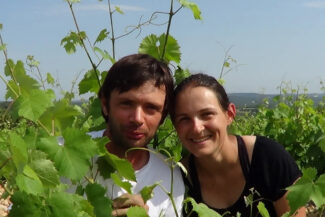
Vincent and Sophie Guizard, Domaine Saint Sylvestre
Guizard knows his terroir as well as his wife Sophie knows the wine business; together, they created Domaine Saint-Sylvestre in 2010 with 17 acres he owned as part of Domaine de Montcalmès, the winery he worked alongside his cousin, Frédéric Pourtalié. Domaine Saint-Sylvestre released its first vintage release in 2011.
Vincent and Sophie employ a sustainable approach to viticulture, a method known as ‘lutte raisonnée’ (the reasoned struggle) and use no synthetic fertilizers or herbicides in the vineyards.
 •3• Domaine Saint Sylvestre, 2015 Terrasses du Larzac ($39) – One Bottle
•3• Domaine Saint Sylvestre, 2015 Terrasses du Larzac ($39) – One Bottle
70% Syrah, 20% Grenache, 10% Mourvèdre. A beautifully-aged Larzac blend showing dried cranberry, sweet leather, crushed stone, garrigue and woodsmoke. Total production, 1375 cases.

Rich-iron red Ruffe soil
Le Clos du Serres
Terrasses du Larzac, Languedoc
Says Beatrice Fillon, “We chose this new occupation to rebuild their lives, to abandon a lifestyle where speed was of the essence and which seemed to us to be more and more unreal.”
She is referring to the decision she made with her husband Sébastien to purchase the 40-acre domain Clos du Serres. It was a life-changing move for the couple. Born in St Etienne, Sébastien grew up in a rural, agricultural environment and was familiar with working the land, but it was Beatrice, who hails from Montpellier, who chose the area: “We wanted to move south to the only region where there is still land to clear.”
Sébastien adds, “We were won over by the quality of life, surrounded by wild, unspoilt nature, set among olive groves, vines and the wild garrigue, close to some great natural sites—Lake Salagou, Saint-Guilhem-le-Désert, the Hérault gorges—but not far from Montpellier or the sea at the foot of the Larzac plateau.”
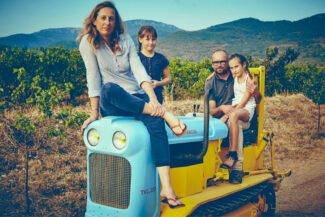
The Fillons, Le Clos du Serres
The domain is organically certified and the Fillon’s philosophy is built around the idea that a wine’s quality has its roots in the vine, but terroir gives nothing without being worked. To this effect, each of their parcels are cultivated with individual attention: “In winter, we leave the grass between the rows of vines to avoid erosion during the heavy autumn rain and enhance the soil’s life,” says Sébastien. “We start ploughing with the first warm days getting rid of the grass naturally thus ensuring it doesn’t challenge the vine’s access to water. During the winter we treat with organic material; grape-based compost and manure from animals bred on the Larzac plateau.”
Work in the cellar is equally meticulous, according to Fillon: “We use ‘tronconique’ (conical) concrete vats and other small ones made of glass fiber with floating ‘hats.’ Thanks to the shape of the concrete vats, the ‘marc’ hat sinks into the juices, resulting in soft and natural extraction, so that fermentation based on the grapes’ natural yeast is very steady. The glass fiber vats mean we can work with very small volumes, maximizing our ability to vinify parcel by parcel. Proof is that our winery boasts 17 vats for 15 land parcels.”
 •4• Le Clos du Serres ‘Le Palas’, 2018 Terrasses du Larzac ($33) – One Bottle
•4• Le Clos du Serres ‘Le Palas’, 2018 Terrasses du Larzac ($33) – One Bottle
From a west-facing lieu-dit adjacent to the village of Saint-Jean de la Blaquière, this organically-certified blend of 38% Syrah, 32% Carignan, 30% Grenache is aged in concrete and shows blackberry and plum preserves with citrus notes accompanying licorice, black pepper and graphite. Total production, 250 cases.
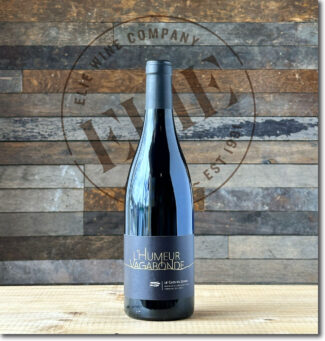 •5• Le Clos du Serres ‘L’Humeur Vagabonde’, 2019 Terrasses du Larzac ($39) – One Bottle
•5• Le Clos du Serres ‘L’Humeur Vagabonde’, 2019 Terrasses du Larzac ($39) – One Bottle
70% Grenache, 15% Cinsault, 15% Carignan; this tiny production wine (whose name loosely translates to ‘The Wandering Mood’), shows ripe blackberry, cherry and blackcurrant behind hits of coffee and chocolate with an impressive spice finish touched with clove and violet. 125 cases produced.
- - -
Posted on 2024.02.17 in France | Read more...
Lure Of The Loire II: A Wide Range Of Red Varieties, Soils And Microclimates Allow For A Diversity Of Wines And Styles By Upstart Generation
The media engine behind French wine seems driven primarily by two wheels—Burgundy and Bordeaux—while the Loire is often relegated to third-wheel status. And it’s not from want of praise: The vivid, crisp, hauntingly aromatic and almost supernaturally focused wines of the Loire Valley are arguably the pinnacle of each particular varietal.
And there are many. 24 varieties flourish throughout the Valley (including indigenous, newly-revived grapes such as Pineau d’Aunis) alongside the Big Four, Melon de Bourgogne, Sauvignon Blanc, Chenin, and Cabernet Franc. The Loire Valley is the biggest producer of white wine in France and the second biggest producer of sparkling wines; it encompasses four sub-regions with more than 51 appellations surrounding the Loire River and its tributaries, flowing from the east around Sancerre to the west toward Muscadet on the Atlantic coast at the mouth of the river.
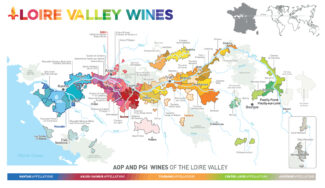
The Loire is also a hot-bed for experimental winemakers, some of whom have chosen to forgo the hidebound restrictions of the French wine bureaucracy and produce wines on their own terms, opting to use the all-encompassing Vin de France appellation on their labels rather than the prestigious AOPs they’d otherwise be entitled to. Lovers of natural wine know that the Loire was an early pioneer in the movement, and that such producers make wine with organic and/or biodynamic fruit, native yeasts, and a commitment to low-intervention viniculture as a bid for sustainability in the face of changing environment.
These upstart young winemakers have not only been flying under the mainstream radar, they have created their own generation of satellites—fans that recognize wine as an agricultural product as well as a cultural phenomenon, and are drawn to their dedication to natural farming.
This week’s wine selection looks upward toward the light that vignerons in three specific Loire appellations—Anjou-Saumur, Touraine and Fiefs Vendéens—are shining on technique, innovation and originality.
Anjou-Saumur: Driving a Full-on Revolution
In France, where plenty of revolutionaries wound up with their heads in a guillotine basket, ‘revolution’ is not a word to be used lightly. Still, Richard Leroy of Domaine Sophie et Richard Leroy in Bellevigne-en-Layon, Anjou, uses it easily: “There’s a revolution happening in wine right now,” he says, referring to Anjou, once an epicenter for sweet wines like Coteaux-du-Layon and Quarts-de-Chaume.
Over the past twenty years, Anjou has become a hub for a different kind of wine—those made with a minimum of artifice in the cellar, free from historical baggage about what they should taste like and often produced by first-generation winemakers with no family ties to wine.
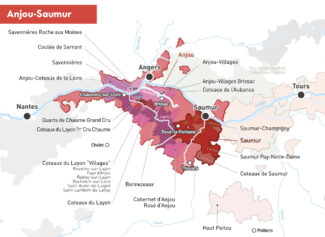
Another phase of the revolution is the revival of Chenin, which fell out of favor during the second half of the last century as did the native red wine grape, Grolleau. Mark Angeli of La Ferme de la Sansonnière, who arrived in 1989, claims, “Dry Chenin had been gone from Anjou for 50 years, and the few reds being made were mostly rot-gut. Appellation rules required them to be made from the two Cabernets—Franc and Sauvignon—even though old-vine parcels of Grolleau and Pineau d’Aunis thrived throughout the area.”
The region has been attracting maverick winemakers who recognize the scant precedent for complex, dry wines made from Chenin and Grolleau, and who have been happy to bottle their rule-busting wines, farmed organically, under the relatively lowly ‘Anjou’ appellation or even labeled simply as ‘Vin de France.’
Touraine: The Original Breeding Ground of Pioneering Winemakers And Natural Wines
Most people are more familiar with the Loire’s bookends, Muscadet and Sancerre. But between them lie 79 AOPs representing what InterLoire (the official organization of producers, merchants and traders involved in the production and promotion of Loire wines) calls, “The most extensive, diversified and original vineyards in Europe.”
The AOP covering Touraine stretches from Anjou to the west to the Sologne in the east, converging near the point where the Loire River and its tributaries meet. It covers 104 communes in Indre-et-Loire and 42 in Loir-et-Cher.

Most of the vineyards are located southeast of Tours on the slopes that dominate the Cher River and the land between the Cher and the Loire. With nearly 13,000 acres under vine, the climate varies dramatically as you move inland; oceanic conditions dominate the west, becoming more continental as you move east. These climatic differences combined with varied soils determine the choice of grape variety planted (with later-ripening varieties grown in the west and earlier-ripening ones in the east) and account for the wide variety of wine styles produced.
Among these styles are the personal statement wines of natural winemakers, who have found in Touraine a vibrant opportunity for self-expression as well as terroir that, through minimal intervention, display their origins perhaps even more faithfully than their rule-bound AOP counterparts.
Cabernet Franc
Who’s your daddy? Biologically, both Cabernet Sauvignon and Merlot share Cabernet Franc as a parent, and the grape itself displays characteristics inherited by both. In cooler climates, Cabernet Franc shows off graphite and red licorice notes, while in warm regions, it exhibits tobacco and leather aromas. There is also a vegetal edge, which may strike the palate as tasting of green pepper or jalapeño.
In Bordeaux, it is generally a minor component of Cabernet Sauvignon and Merlot blends, although in Pomerol and Saint-Émilion it adopts a larger, more highly-regarded role. Château Cheval Blanc, for example, is typically around two-thirds Cabernet Franc while Ausone is an even split between Cabernet Franc and Merlot.
With the Loire Valley’s cool, inland climates it becomes a star performer. The appellations of Chinon (in Touraine) along with Saumur and Saumur-Champigny (in Anjou) are important bastions of Cabernet Franc, where the wine is prized for forward aromas of ripe summer berries and sweet spices.
The local Loire Valley name for Cabernet Franc is Breton; a reference to the man credited with bringing the variety to popularity in the 17th Century.
Yannick Amirault (Touraine)
‘Fifty and out’ could be the mission statement of Domaine Y. Amirault, at least in terms of size. With around 30 acres in Bourgueil and 20 in Saint-Nicolas-de-Bourgueil, Yannick Amirault has grown his vineyard space as large as he cares to, finding 50 acres to be the most he feels he can work to his exacting standards.
Having begun in 1977 with around ten acres inherited from his grandfather, Eugène Amirault, he was joined by his son Benoît in 2003. Yannick’s commitment to organic agriculture is not an attempt to hop on the bandwagon sweeping across French viticulture, but rather the opposite: “Weaning the vineyards off synthetic inputs—a process we completed in 1997—and following lunar calendar—may seem a bit trendy, but this is simply a return to the way Eugène Amirault made wine for his family.”
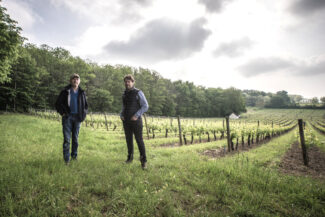
Yannick And Benoît Amirault, Yannick Amirault (Bourgueil, Saint-Nicolas-de-Bourgueil) – (Photo © Jerome Paressant)
Benoît adds: “Harvest has always been done by hand and is initiated by many factors, all guided by combined experience. Each parcel is picked at its own optimal ripeness (and in several passes), then the grape clusters are transported to the cellar. Here, the work is both minimalistic and transparent: Grapes are sorted again and destemmed; fermentations are indigenous and conducted in large, open-topped, conical oak vats; macerations last up to sixty days with pigéage only at the very beginning and rémontage reserved only for the ripest vintages to reduce rustic tannins. Only the first press is used and is aged in neutral vessels—amphorae, oak demi-muids and well-seasoned vats.”
The result of this is a vibrant array of 100% Cabernet Franc wines, many reflecting individual plots across the two appellation; the domain has 25, some above the village on sands and gravels, others at the hill’s feet, in limestone.
“There is no terroir without the intervention of mankind,” says Yannick. “We look after our vines, year after year, as if it were a garden. We grow grass between vine rows and we plough the graveled plots which are more sensitive to a lack of water. Despite weather, our craft leaves nothing to chance. The pruning is Guyot-Poussard and vines through organic spraying of plants infusion. We also roll growing vines (we do not cut the top branches) on certain crus. Even in a low yield year, we do a growth clearing on all our vines in order to ensure an homogenous maturity of the grapes.”
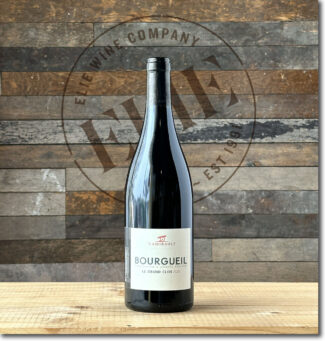 Yannick Amirault ‘Le Grand Clos’, 2020 Bourgueil ($36)
Yannick Amirault ‘Le Grand Clos’, 2020 Bourgueil ($36)
Amirault owns five acres of the lauded, south-facing hillside Le Grand Clos lieu-dit, which is composed of clay and flint soils over tuffeau bedrock. Certified organic, his vines are 45 years old. The grapes are hand-harvested in successive passes, destemmed and allowed natural yeast fermentation in oak vats, and after four weeks of maceration, the wine is transferred to 400 liter French oak barrels for a minimum of one year. The wine is an earthy, black-fruit driven Cabernet Franc that shows the pencil-shavings graphite that are typical of the appellation, one of the few in Loire appellations to produce exclusively red wines.
 Yannick Amirault ‘Les Malgagnes’, 2020 Saint-Nicolas-de-Bourgueil ($42)
Yannick Amirault ‘Les Malgagnes’, 2020 Saint-Nicolas-de-Bourgueil ($42)
Les Malgagnes is a hillside lieu-dit in the Bourgueil sub-appellation of Saint-Nicolas-de-Bourgueil. It is slightly further down the limestone-rich slope than the other three lieux-dits on this particular côte. Amirault has six acres here, but only the fruit from the upper section, where the limestone is much closer to the surface, is used for this cuvée. The grapes see a four-week maceration with an élevage lasting 12 months in large barrels and demonstrate the silky elegance of old-vine Cabernet Franc grown in this pretty AOP; rich cassis notes are woven into fine-grained tannins and bittersweet chocolate on the finish.
Pierre Borel (Touraine)
The six-acre Clos du Pavée, where Pierre Borel has been making wine since 2006, is a true clos in the French sense, meaning that it a walled vineyard, once done to protect the grapes from theft and now, to improve the mesoclimate. Pavée soils are gravel; the surrounding acres are generally built around clay/limestone.
“Terror dictates wine style,” Pierre explains, “and this terroir I believe is meant to produce more easygoing, fruit-forward wines.”
This concept ultimately led Pierre to uproot and replant the whole parcel, settling on four new acres of Cabernet Franc and two of Chenin. Doing all the vineyard work alone (and by hand) Pierre is a firm believer in organic viticulture, and although he doesn’t believe that the AOP system is necessarily a mark of quality, he views working within it a commitment to the winemaking traditions in the area.
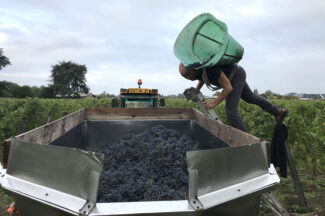
Pierre Borel (Bourgueil)
The seclusion of Clos du Pavée works to the advantage of Pierre’s passion for organics. With the village on one side and woodland on the other, his acres are under very little threat from contamination from neighboring growers who aren’t playing by his rules. He believes that his wines represent the purity and typicity of wines from Bourgueil—and that is his goal.
“Simplicity is key,” he states. “I make only one wine, and vinify in as straightforward a way as possible. I work with sandy limestone/gravel soils that yields plush, herbaceous and fragrant fruit. I ferment in a simple chai that contains one large tank of stainless steel and one of fiberglass. The wine is racked off the skins after a couple of weeks of maceration and is bottled from tank, with no barrel aging.”
He is also pleased to note that as his new vines mature, they are producing more complex and nuanced wine with each passing vintage.
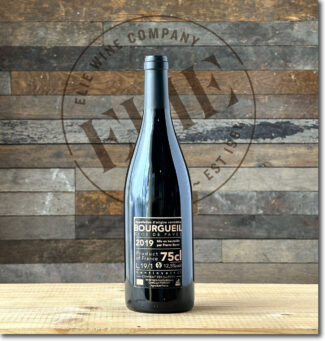 Pierre Borel ‘Clos de Pavée’, 2019 Bourgueil ‘natural’ ($33)
Pierre Borel ‘Clos de Pavée’, 2019 Bourgueil ‘natural’ ($33)
Bourgueil is the heartland of Cabernet Franc in the Touraine district, and Borel’s five gravelly acres in Clos de Pavée are the epicenter of Bourgueil. This savory, natural red is replete with the meatiness that develops in Cab Franc under ideal condition, and here it is offset by crunchy cranberry and rich herbaceous notes. There is dark chocolate on the finish now, but the wine is structured to mature for at least another decade, and should develop the truffle-like savory tones.
Manoir de la Tête Rouge (Anjou-Saumur)
Intense, driven and passionate, Guillaume Reynouard is the fox in charge of the chicken coop—as well as being a winemaker, he is president of the Syndicat des Vins Saumur and has a particular enmity for growers who rip out Pineau d’Aunis in favor of easier-to-grow varieties.
Taking charge of Domaine Manoir de la Tête Rouge in 1995, Guillaume soon converted to organics and was certified Biodynamic in 2010. The estate enjoys remarkably productive clay/ limestone terroir and he takes pride in ‘living vineyards’ where the soil is worked by hand to ensure that roots go deep and grass grows between rows to promote insect and other plant life; synthetic chemicals are prohibited. In the cellar, grapes are fully destemmed, indigenous yeasts are preferred, with no additions and very minimal sulfur use.

Guillaume Reynouard, Manoir de la Tête Rouge (Saumur, Saumur-Champigny)
According to Reynouard, “Responsible agriculture is a way of life and of thinking. When growing grapes, I aspire to act sensibly for the planet—a state of mind that develops naturally from a respectful relationship with nature. Knowing how to adapt to a changing environment requires constant questioning while the planting of forgotten varieties such as Pineau d’Aunis, the incorporation of trees into the cultivation of the vine (agroforestry) and the gradual abandonment of ‘modern’ oenology are avenues that I have followed for more than 20 years.”
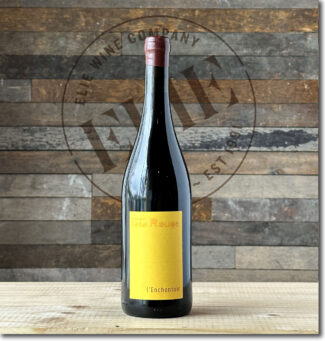 Manoir de la Tête Rouge ‘l’Enchentoir’, 2018 Saumur-Puy-Notre-Dame ‘natural’ ($43)
Manoir de la Tête Rouge ‘l’Enchentoir’, 2018 Saumur-Puy-Notre-Dame ‘natural’ ($43)
In the sub-appellation Saumur-Puy-Notre-Dame, ‘l’Enchentoir’ is a venerable Cabernet Franc lieu-dit. Planted over Turonian limestone in 1959 using sélections massales, the pressed wine is aged in 300-liter barriques for one year plus another six months in Béton cuves (pre-cast concrete tanks). It displays depth and delicacy, showing blackberry and cherry over violets, rose petals and savory herbs.
 Manoir de la Tête Rouge ‘Tête de Lard’, 2018 Saumur-Puy-Notre-Dame ($27)
Manoir de la Tête Rouge ‘Tête de Lard’, 2018 Saumur-Puy-Notre-Dame ($27)
100% Cabernet Franc from two parcels averaging 20 years of age, ‘Tête de Lard’—Head of Bacon’—is fermented on native yeasts and spends a year in used 300-liter barrels. The final blend is done in concrete tanks, where the wine rests for 4 months before bottling. Filled with ripe tones of blueberry and cassis with a slight vegetal edge, this is a natural wine suited for the cellar, but one that should be tasted every couple years to keep an eye on the progress.
 Manoir de la Tête Rouge ‘Bagatelle’, 2020 Saumur Rouge ($21)
Manoir de la Tête Rouge ‘Bagatelle’, 2020 Saumur Rouge ($21)
A bagatelle is something easy; something that requires little effort. This is not a comment on the precision that is de rigeur in Guillaume Reynouard’s winemaking, especially since the tech sheet for this wine specifies the terroir as 30% Jurassic limestone, 60% Turonian limestone and 10% silt, and the vines as being pruned in alternating Guyot-Poussard. Rather, the wine itself is created simply and naturally, macerated three weeks without yeasting, without chaptalization and without additives, then matured without sulfur. These minuses equal an ultimate plus; a pure Cabernet Franc with aromas of plum, raspberry, and cherry with notes of red pepper, spice, and graphite with silky tannins and bright acidity.
Terre de l’Élu (Anjou)
For Charlotte and Thomas Carsin, winemaking is many things—an interest, then a passion, then a commitment, then a profession. But first and foremost, it’s an adventure.
“My path to Clos de l’Élu began as a grape picker in Burgundy,” Thomas shares. “I was studying tropical agronomy, but ultimately chose to specialize in wine and found work placements in Sonoma, where I learned a great deal about terroir and vinification.”
After that, he learned the retail side of the business in a Paris boutique and spent five years doing consultancy work in Champagne. By the time his stint as a journeyman was over, he had arrived at a very keen personal opinion of the ‘overengineered’ wine industry: He hated it.
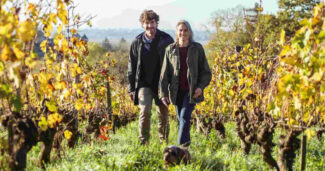
Thomas and Charlotte Carsin, Terre de l’Élu (Anjou)
By then he was well-versed in ‘winegrowing empiricism’—the language of the vines and master the idea of terroir. He spent a few more years making wine in Provence, in the département du Var, but it wasn’t until 2008 that he was able to acquire a domain and produce wine on his own terms: “Acquiring Clos de l’Élu, in the heart of the Layon valley, was a dream come true.”
Charlotte’s road to the winery was a bit more straightforward. Having worked in communication with specialized interest in pairing food and wine, she has learned the technical angles hands-on. Of course, her professional chops allow her to serve as the wineries administrator, in the sales and marketing of the winery, and especially brand image, packaging, events, and communication methods.
As to the estate, Terre de l’Élu is in Saint Aubin de Luigné; the vines grow on the outskirts of the village between Chaume and Ardenay, on the right, south-facing side of the Layon River. Soils here are classic Anjou Noir, full of volcanic rocks, sandstone and quartz.
 Terre de l’Élu ‘Maupiti’, 2021 VdF Loire-Anjou Rouge ($26)
Terre de l’Élu ‘Maupiti’, 2021 VdF Loire-Anjou Rouge ($26)
Thomas and Charlotte Carsin may have thrown a dart at a map of French Polynesia and landed on the tiny island of Maupiti to name this wine, which they describe as ‘approaching like a mysterious island amid the languor of oceans; you want to explore.’ A blend of 30% Gamay and 70% Cabernet Franc from vines between 25 and 40 years old, the grapes are whole-cluster-fermented separately on native yeasts and only blended after the completion of malolactic. The wine retains the brightness of Anjou Gamay, showing vivacious raspberry aromatics and the solid savory core of Cabernet Franc.
Le Sot de l’Ange (Touraine)
Although the label’s name roughly translates to ‘Idiot Angel’, winemaker Quentin Bourse is anything but. Before taking over a friend’s estate in time for the 2013 vintage, Bourse worked in various fields (some wine related; others not) including numerous internships in the surrounding area. Having learned technique from both natural and conventional producers, notably a six-month stage at the famed Vouvray producer Domaine Huet, his winemaking philosophy was shaped by philosophy and a relentless work ethic that leans toward innovation and the sort of perfectionism that is often at the root of natural wines—at least the ones that shine.
Unusual for the neighborhood, Bourse’s estate is certified biodynamic. Ranging across 30 acres, he is especially attracted to indigenous varieties that capitalize on the clay and silica soils for which the region is famous. In many of his parcels, white silex stones litter the rows making it look as if the terroir is seeping from the earth.
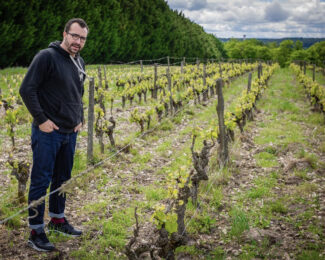
Quentin Bourse, Le Sot de l’Ange (Touraine)
He shares a cellar with old-school producer Pascal Pibaleau, where his grapes are painstakingly sorted four times before whole-cluster fermentation with indigenous yeasts in tank, and then a slow, gentle pressing that in some cases lasts five or more hours. Aging occurs either entirely in tank, neutral barriques, or amphorae depending on the cuvée, and zero sulfur is added during the winemaking process for the reds; a touch is added for the whites.
 Le Sot de l’Ange ‘Karadras’, 2018 VdF Loire-Touraine Cabernet Franc ‘natural’ ($24)
Le Sot de l’Ange ‘Karadras’, 2018 VdF Loire-Touraine Cabernet Franc ‘natural’ ($24)
‘Karadras’ is 88% Cabernet Franc and 12% Côt; the name proves to be somewhat inexplicable since it appears in different spellings on different bottlings. What remains the same is that after being manually destemmed in wicker baskets, the fruit ferments in open wooden tanks and comes out the other end with a classic profile; a bit of color from the Côt, herbaceous notes from the Cab Franc. It offers dusty plum, soil, cocoa, and brambles; the palate is lively and fresh, lifted by crunchy acidity framing the ripe high-toned blue fruits, juicy plum and earthy spices.
Côt
‘Côt by any other name would smell like Malbec.’ With apologies to the Bard, the renaissance of this dark, potent grape in the Loire sees a remarkable change in profile. In southwest France—Cahors in particular—the variety produces heavy wines that are not only amenable to long periods of aging, they virtually demand it. In the Cher Valley, in the heart of Touraine, the grape finds a kinder, gentler environment where it produces a different sort of wine; less aggressively tannic with fresh aromas of black cherry and cassis. In part, it is the climate, but the fiercer aspects Côt as they appear in Cahors’ ‘black wines’ are tempered in the field, where vines are pruned short with a vendange vert after véraison. To avoid the additional tannins of oak, most of the grapes are fermented and aged in stainless steel tanks with a few barriques blended in.
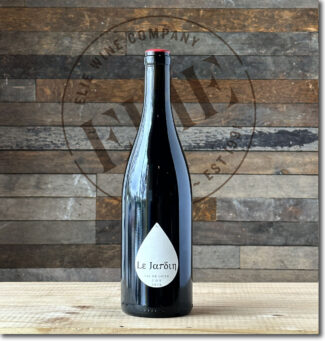 Le Sot de l’Ange ‘Le Jardin’, 2018 IGP Val-de-Loire ‘Côt’ ‘natural’ ($45)
Le Sot de l’Ange ‘Le Jardin’, 2018 IGP Val-de-Loire ‘Côt’ ‘natural’ ($45)
100% Côt from an interesting lieu-dit with two distinct soil types—one section with clay and silex soils and the second with clay and limestone. The wine is vinified using whole-cluster fermentation in concrete tank; malolactic fermentation and élevage occur in terra cotta amphorae for 24 months. The wine shows aromas of freshly-picked bramble fruits, blackberry and currant, with slight Szechuan pepper notes and a touch of clove; a fresh, gripping palate.
Le Rocher des Violettes (Touraine)
Louis Barruol is known to be a tough taskmaster; he is the legendary Château de St-Cosme winemaker who transformed the family’s Gigondas estate from an anonymous bulk-wine source to the top winery in Gigondas—arguably into one of the best estates in the Southern Rhône. It is here that Xavier Weisskopf, founder of Le Rocher des Violettes (in 2005) went to work after studying winemaking in Chablis and Beaune and earning his degree in viticulture and oenology.
At Château de St-Cosme, Weisskopf rose to the rank of Chef de Cave, making four vintages during his tenure there. But he recognized that Rhône was not the best spot to grow his pet grape, Chenin, and that Montlouis-sur-Loire was. In 2005, he was able to purchase a site of old Chenin vines, many planted before World War II, in Montlouis, as well as Côt vines in Touraine, and he settled in to produce wines that allowed his new terroir to speak with clarity. This involved converting the farming practices to organics and extending the philosophy of ‘tradition’ to the cellars.

Xavier Weisskopf, Le Rocher des Violettes (Touraine, Montlouis-sur-Loire)
“Since 2010, my wife Clémence has been a part of the adventure, excelling in the administrative and commercial side of the business,” he says. “We have an additional team who work according to the season. Among our projects, we have been involved in an attempt to restore old vines to their original condition. We have dug a cellar in our native tuffeau so that the wines may age in the best conditions; it is built on multiple levels so that our mechanical force is provided by gravity. The constant cellar temperature is between 13 ° and 14 °C, allowing for the thermal self-regulation of the Allier oak barrels during fermentation.”
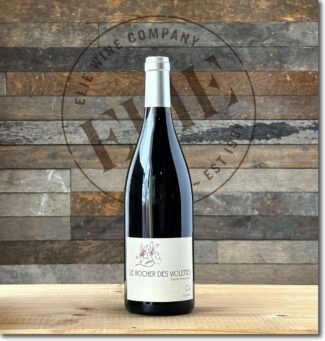 Le Rocher des Violettes ‘Côt’, 2020 Touraine ($23)
Le Rocher des Violettes ‘Côt’, 2020 Touraine ($23)
From seven individual plots, the grapes are 80% whole cluster fermented and aged 14 months in neutral foudres. The Malbec nose is unmistakable—a powerful blend of sweet and sour cherry and country herbs that, given time to open up, reveals coffee, leather, black pepper, vanilla and tobacco.
Pineau d’Aunis
‘Riches to rags’ may well summarize the Pineau d’Aunis story. Once a popular and sought-after variety among royalty on both sides of the English Channel, it is now increasingly rare, and generally limited to rosés and the lighter reds of the central Loire.
Part of the grape’s fall from grace is the fact that it is simply a pain in the neck to grow. Prone to irregular yields, it is also highly susceptible to bunch rot and hyper-sensitive to the soil it is grown in, requiring a balance of clay, sand and gravel in order to produce a crop of much commercial value. It is only in seasons of prolonged heat that it is capable of making red wine as distinctive and interesting as that made from the more ubiquitous Cabernet Franc.
And yet, of late, warmer seasons is exactly what has been happening in the Loire and as the more experimentative winemakers of the region are discovering, the dry reds made from the grape under optimal conditions show how presentable Pineau d’Aunis can be at the table of either kings or pawns.
 Terre de l’Élu ‘Espérance’, 2021 VdF Loire-Anjou ‘Pineau d’Aunis’ ($47)
Terre de l’Élu ‘Espérance’, 2021 VdF Loire-Anjou ‘Pineau d’Aunis’ ($47)
100% Pineau d’Aunis from a variety of vine ages (seven years to 60), grown on rocky clay and schist. The grapes are allowed two weeks to macerate whole-cluster in stainless steel; they are then pressed and aged in neutral oak as fermentation completes. The wine is bottled with a minimum of sulfur and no fining. It shows the floral nose and spicy, fleshy body associated with this ancient grape; dried violet opens to raspberry and spiced cherry with a bit of crushed stone toward the finish.
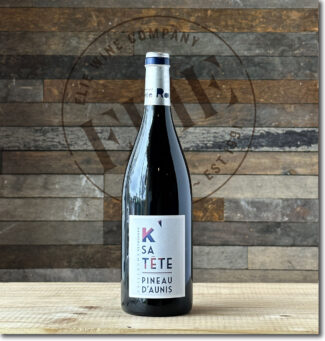 Manoir de la Tête Rouge ‘K’ Sa Tête’, 2020 VdF Loire-Saumur ‘Pineau d’Aunis’ Guillaume Reynouard ($27)
Manoir de la Tête Rouge ‘K’ Sa Tête’, 2020 VdF Loire-Saumur ‘Pineau d’Aunis’ Guillaume Reynouard ($27)
100% Pineau d’Aunis from the lieu-dit de l’Enchentoir where soils are treated using Maria Thun’s biodynamic advice; this includes cow-horn dung in the spring and horn silica after closure of the cluster (a somewhat exacting process that is exactly what is sounds like, using cow-horns filled with manure and/or silica). Maceration lasts 12 days in concrete tanks without yeasting, chaptalization or additives. The wine spends six months in oak barrels and bottling is done in June with 20 milligrams of added sulfur. This is a textbook Pineau d’Aunis with black pepper and green pepper on the nose with a palate that expands to include sweet, perfectly ripe blueberries.
Grolleau
Grolleau is the Loire Valley’s workhorse grape, used most often in the production of rosé. Although it remains one of the Loire’s most planted red-wine varieties, new plantings have dropped steadily for the last 50 years. While Grolleau is high yielding, providing a steady, reliable harvest, it poses several challenges for growers as it is susceptible to disease and not a particularly flavorful stand-alone variety. It is a dark grape on the vine, but thin-skinned, meaning that there is not much chance for color extraction, so it is rarely used to produce red wines.
Grolleau-based wines tend to be high in acid, moderate in alcohol, and may show aromas of strawberry, raspberry and cherry; as a rosé, it is reminiscent of watermelon, tangerine, rose petals and red candy.
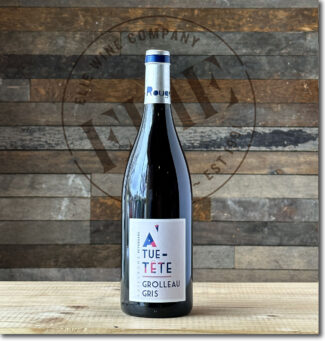 Manoir de la Tête Rouge ‘À Tue Tête’, 2021 VdF Loire-Saumur ‘Grolleau Gris’ Guillaume Reynouard ‘natural’ ($25)
Manoir de la Tête Rouge ‘À Tue Tête’, 2021 VdF Loire-Saumur ‘Grolleau Gris’ Guillaume Reynouard ‘natural’ ($25)
Vin de France is the most basic quality tier for wines from France, typically uncomplicated everyday drinks, likely blends, but occasionally are made from unlisted, unqualified varieties. Loosely translated to ‘loudly’, ‘À Tue Tête’ is a rare bottling from an even more rare variety, Grolleau Gris, which is a pink-skinned mutation of Grolleau. Handled with the biodynamic tool-kit, the wine shows red cherry, sandalwood and a bit of tropical fruit.
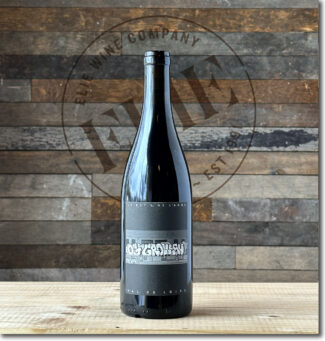 Le Sot de l’Ange ‘OG Grolleau’, 2020 IGP Val-de-Loire ‘natural’ ($39)
Le Sot de l’Ange ‘OG Grolleau’, 2020 IGP Val-de-Loire ‘natural’ ($39)
IGP (Indication Géographique Protégée) is a quality category used for French wine positioned between Vin de France and Appellation d’Origine Protégée (AOP). (The category superseded Vin de Pays in 2009.) Most significant in commercial terms is the fact that the wines may be varietals and labeled as such. ‘OG Grolleau’ comes from single parcel of old-vine Grolleau planted between 1945 and 1976; grapes are de-stemmed, given ten days of maceration, aged in amphorae and used oak barrels, then bottled without sulfur. Blueberry and violet dominate the nose while the palate resolves itself in a mineral crunchiness with beautiful acidity.
Domaine Marie Thibault (Touraine)
“I grew up in the Loire Valley, but unlike many vignerons working in the Loire, I did not come from a winemaking family,” says Marie Thibault, adding, “But also unlike many of them, I have degrees in both biology and oenology.”
Marie Thibault began making wine in the early 2000s, working for a time with François Chidaine in Montlouis, where she fell in love with Chenin. In 2011, she founded her own nine-acre estate on a single windy slope in Azay-le-Rideau, a lesser known commune of Touraine. She immediately converted to organics and has been certified with Ecocert since 2014. Among the natural elements in her vineyards is the flock of two dozen ewes that graze between the vine rows during the autumn; every ten days, they are penned inside a new hectare to keep the soil naturally fertile and the grass clipped.
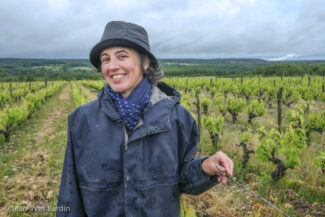
Marie Thibault, Domaine Marie Thibault (Touraine) – (Photo © Jean-Yves Bardin)
“My vineyard is small, but the soils are extremely varied and as such, so are the grapes I grow. I work with Côt (Malbec), and have a special love for Gamay, Grolleau, Chenin and Sauvignon Blanc. Most of my vines are at least 50 years old. I compensate for small production by purchasing from organic estates nearby.”
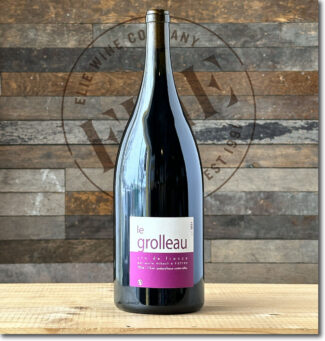 Domaine Marie Thibault ‘Le Grolleau’, 2021 VdF Loire-Touraine Rouge ‘natural’ ($89) 1.5 Liter
Domaine Marie Thibault ‘Le Grolleau’, 2021 VdF Loire-Touraine Rouge ‘natural’ ($89) 1.5 Liter
A wine whose heritage is perfectly reflected in Thibault’s scant acres—Azay-le-Rideau is ground zero for Grolleau, first planted in early 19th century. ‘Le Grolleau’ is an ultra-fresh example made using Beaujolais-style carbonic maceration and held to a little over 11% abv, which solidly qualifies it as a ‘vin de soif.’ It is made using 60-year-old organic vines planted on hillsides on the southern slopes of the Indre—an early-ripening terroir filled with draining soils with a presence of flint, and bottled at the Estate in April 2022 without fining or filtration and just a micro-dose of sulfur. This wine is kept even fresher en magnum; it is fruity, juicy and velvety with sweet cranberry, blueberry, red plum, blueberry, cranberry, a touch of pepper with black cherry on the finish.
Gamay
Ever since Philippe de Bourgogne cast Gamay from the bosom of Burgundy six centuries ago, the variety has been derided and even despised outside its spiritual home, Beaujolais. Folks who were soured by the sweet and fruity Nouveau cult may bring that prejudice into Touraine, but that would be a mistake: Although once in the shadow of Anjou Gamay, select vignerons in Touraine have made monster strides with Gamay over the past couple decades and these wines now edge out the Gamays of Anjou in depth and complexity. They tend to be medium-bodied with a musky tone that share center stage with aromas of fern and capers intermingled with flinty minerals and plummy notes.
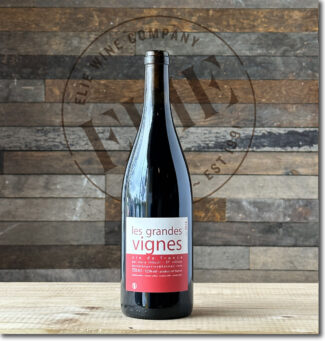 Domaine Marie Thibault ‘Les Grandes Vignes’, 2018 VdF Loire-Touraine ‘Gamay’ ‘natural’ ($41)
Domaine Marie Thibault ‘Les Grandes Vignes’, 2018 VdF Loire-Touraine ‘Gamay’ ‘natural’ ($41)
Thibault’s unique lens on Gamay is seen in this example produced from 50+ year-old vines she discovered growing adjacent to her plot on flinty silex soil. The vines were untrained and un-trellised, and harvest was exceptionally labor-intensive. She allows a 10-month maceration in order to shows off the Gamay’s savory side, with crisp rhubarb, earthy red berry notes and fine-grained, well-integrated tannins showcased.
Famille Percher (Touraine)
Perhaps the most interesting parcel farmed by Luc Percher (of Domaine l’Epicourchois) is ‘La Marigonnerie’ directly adjacent to the winery. In Napoleon times the vineyard area was a pond, and although the region sits on a bed of limestone sprinkled with granitic sand, the pond left behind a bed of clay which, about 120 years ago, was planted to Romorantin—a local white wine variety with its own appellation (Cour-Cheverny) where it is the only grape permitted.
Luc began making wine here in 2005. “When I arrived, the sand was as white as a beach. I fell in love with the ambience—a few wispy trees and an expansive horizon-line. It is quiet terroir.”
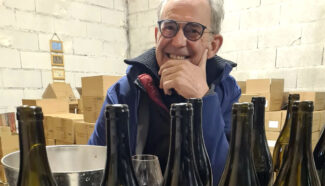
Luc Percher, Famille Percher (Cheverny, Cour-Cheverny)
His 22 acres of vines, tended with certifications from BIO and Déméter, is hardly restricted to Romorantin, although only his 100% Romorantin can be labeled Cour-Cheverny. His Sélection Massale old-vine vineyards contain ten different grape varieties, and some even more rare than Romorantin—Menu-Pineau, Gamay Fréaux and Chaudenay, for example. In order to maintain the biological heritage of these grapes, Luc is committed to soil maintenance, through hilling, stripping, scratching and the establishment of controlled natural grassing. “These practices are respectful of the earth, the plants and the environment; they support the development of biodiversity and preserve the terroirs. You no longer see the white sand between the vine rows—it is covered by grass and other vegetation. We echo that philosophy in the cellar, being minimalist on the interventions in order to more faithfully reflect the grape varieties and the purity of place.”
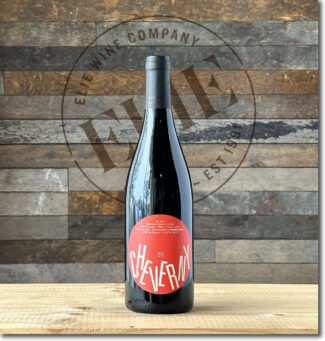 Famille Percher, 2019 Cheverny Rouge ($36)
Famille Percher, 2019 Cheverny Rouge ($36)
A 50/50 blend of Pinot Noir and Gamay grown on sandy clay with a limestone base. It is fermented with indigenous yeast and spends 15 days macerating before élevage in stainless steel on fine lees. It shows a frisky nose of black cherries and cassis with an edge of earth—graphite, tree bark, espresso and forest floor. Tannins are moderate and the finish is long.
Fiefs Vendéens: Loire Frontiers, More To Nantais Than Just Muscadet
Created in 1984, the Fiefs Vendéens in located in the western end of the Loire Valley, about forty-five miles south of Pays Nantais. Like its neighbors, it boasts a maritime climate and soils that are relatively homogeneous, consisting of red clay derived from schist and limestone and laid over friable bedrock, allowing vine roots to establish themselves and penetrate deeply with ease.
Nevertheless, the appellation is subdivided into five individual zones (the ‘fiefs’ in the name)—Brem, Mareuil, Chantonnay, Pissotte and Vix. Each operates under its own set of rules with its own roster of allowable grapes. The generic AOP covers red, white and rosé wines. While the whites are predominantly made from Chenin and Chardonnay, the reds draw from a pool of five grapes: Pinot Noir, Gamay, Cabernet Franc, Cabernet Sauvignon and Négrette. Depending on the subzone, these are broken into the main grape (at least 40 percent of any blend), complementary grapes (at least ten percent of a blend), and accessory grapes. The rosé is dominated by Gamay and Pinot Noir, and covers about half of the appellation’s production.
Domaine Saint Nicolas (Brem Pinot Noir)
If you were jolly old St. Nick, would you hang around the North Pole during the off-season, or relax in a namesake wine estate in Fiefs Vendéens? If it is the latter, you’ll encounter Thierry Michon—a local legend for his commitment to biodynamics, which is not merely a passion pragmatic consideration.
“For me,” he says, “it is closer to a religion.”
For example, he has purchased buffer acres all around his vineyard to prevent accidental cross contamination and he proudly states that not a single vine on his estate has ever seen a non-organic product. His hundred acre estate is at the extreme southern end of the Loire Delta, just south of Muscadet. But Melon de Bourgogne is not the name of the game here; instead, Thierry works old-vine Chenin, Chardonnay, Grolleau Gris, Gamay, Pinot Noir, Négrette and Cabernet Franc.

Thierry Michon and Sons Antoine and Mickaël (Fiefs-Vendéens Brem)
“We are very simple,” he laughs. “You might say primitive, working by horse and doing everything by hand—or foot.”
And that’s accurate—the harvest is, of course, by hand, but after the whites pass through a sorting table and are then gently pressed and fermented in large wooden vats, the reds are sorted and then crushed by foot. Thierry was recently joined at the winery by his two sons, Antoine and Mickaël, who may no longer believe in Santa Claus, but who definitely believe in Saint Nicolas.
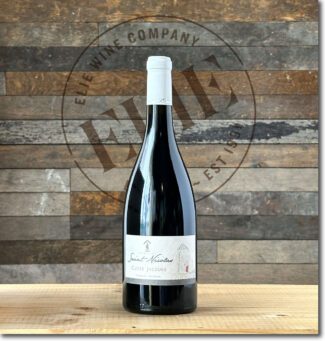 Domaine Saint Nicolas ‘Cuvée Jacques’, 2018 Fiefs-Vendéens Brem ($29)
Domaine Saint Nicolas ‘Cuvée Jacques’, 2018 Fiefs-Vendéens Brem ($29)
100% Pinot Noir between 15 and 25 years old from a gentle hillside facing south-west; schist, clay and quartz soils are enriched using the biodynamic ‘Bordeaux’ mixture, which includes treatments with herbal teas made of nettle and horsetail, etc. The grapes are macerated in wooden vats for 12 days with cap punch-downs. Fermentation is done on native yeast without chaptalization, after which the wine spends a year in oak demi-muids before being bottled unfined and unfiltered, with total sulfites 14 milligrams/liter. The wine is juicy with raspberry and pomegranate, shored up by crunchy minerality and spiced with touches of vanilla, orange rind and cinnamon.
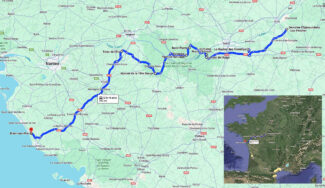
- - -
Posted on 2024.02.02 in Chinon, Saumur-Champigny, Touraine, Anjou, France, Wine-Aid Packages, Loire | Read more...
The Champagne Society February 2024 Selection : Champagne André Heucq + Champagne Solemme
The Rise of Terroir in Champagne
Two New Waves Producers Cultivate The Variety Meunier To Channel Precise Geography in Two Different Sub-regions
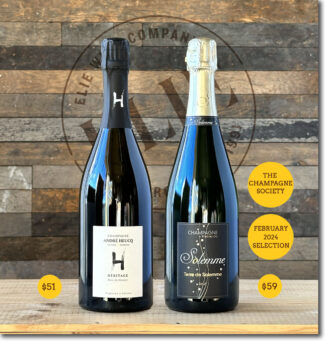
Champagne André Heucq ‘Héritage’ Blanc de Meunier, Vallée-de-la-Marne Brut
Nature ($51)
+
Champagne Solemme ‘Terre de Solemme’, Montagne-de-Reims Premier Cru Villers-aux-Nœuds Brut ($59)
‘First and foremost, Champagne is wine.’
Our Champagne mantra over the past few years has been a bit reductionist: While undeniably accurate, it’s a little like saying that, first and foremost, ‘David’ is a hunk of marble or that at its essence, La Traviata is a bunch of notes. What these self-evident truths leave out is the human touch—the x-factor that makes art from the inanimate and beauty from the base.
As France warms with the rest of the planet, new regional wines are coming into focus and former sow’s ear soils are producing silk purse products. This is a paean to nature, of course, and as always, the passion arises from the people, not from the place. Folks like Alexandre and Fanny Heucq, fourth generation artisan winemakers from the grower house Champagne André Heucq and Olivier Langlais, the winemaker behind Solemme Champagne, who advocates simplicity and honesty in his wines.
These are two standout icons from our Champagne portfolio, but more than that, they are the flesh behind the finesse.
The Impact Of Climate Change on Champagne: Heating-up
Global wine production in 2023 was at its lowest in 60 years, and a lot of the decline can be blamed on extreme weather events, many of which have been worsened by climate change. Italy dropped from its position as the world’s leading wine maker due to numerous adverse weather events, including erratic rainfall that triggered downy mildew as well as floods, hailstorms and drought. In 2021—for the same reasons—Champagne saw the smallest harvest since 1957.
Somewhere amid all these clouds is a silver lining known as the Goldilocks Zone, and we may be living within it as we speak. Ripening grapes has always been a primary challenge in Champagne, located near the northern growing zone limit of its three principal grapes, Chardonnay, Pinot Noir and Meunier. Although the rise in temperature (nearly two degrees between 1961 and 2020) has beneficial effects in the short term, especially at higher elevations, the downsides are legion—earlier budburst makes the risk of frost damage more pronounced, and frost control systems, especially those based on combustion, add to the region’s carbon footprint. Not only that, but warmer days often precede warmer nights, affecting a grape’s natural ability to retain acid, giving Champagne its intangible ‘zing’.
Despite magnanimous efforts to reduce their carbon emissions, including use of bio-based products in the fields and cellars, scrapping much of the mineral fertilizers used in the past and planting of hedges and trees allowing a better absorption of CO2 and storage of carbon in soils, the warming of the region is likely to continue for the foreseeable future—potentially, according to ClimateAi, making Chardonnay and Pinot Noir (and to a slightly lesser extent, Meunier) impossible to grow in the area currently defined as Champagne.
That means we may well be in the midst of a ‘best of both worlds’ phenomenon in Champagne, where the positives still outweigh the negatives and we are able to enjoy riper, richer wine that is today (more often than in the past) of vintage quality. By 2050, who knows?
The Biodynamic Principles: Respecting Earth’s Life Forces
Credit Dr. Rudolph Steiner for codifying the basic principles of biodynamics; his 1924 lecture series to farmers opened a wormhole that integrated scientific understanding with a recognition of an underlying spirit in nature and, indeed, in the cosmos at large. In Cliff’s Notes shorthand, the movement recognizes every farm, garden or vineyard as an integrated organism made up of interdependent elements: Plants, animals, soils, compost, and the classically French view of ‘the spirit of a place.’ Biodynamic farmers listen to the land and work to nurture and harmonize these elements, managing them in a holistic and dynamic way. The goal, whether the crop is grain or grapes, is to develop and evolve a given plot of land as a unique individuality.
These principles are custom made to accentuate terroir, but in Champagne, distinctiveness of location has often taken a back seat to a homogenous blend. As a result, the region as a whole was a bit late to the biodynamic party. The era between 1970 and 2000 may be viewed as cringe-worthy in terms of viticulture; the overuse of pesticides and herbicides and the once-favored fertilizer known as ‘boues de ville’—urban waste—damaged soils even in the most prestigious Grand Cru vineyards.
The biodynamic sun came out at turn of the century, when the Comité Champagne conducted in-depth research into the industry’s environmental impact and launched an ambitious plan, resulting in a 20% reduction in carbon emissions per bottle and a 50% reduction in the use of both phytosanitary products and nitrogen fertilizers. A regional sustainability certification, VDC (Viticulture Durable en Champagne), was introduced in 2014 and today, 15% of Champagne’s vineyards falls under the certification, and ambitions are much higher for the future.

Mountains and Valleys: Two Artisans, Two Different Meunier-Centric Champagne Expressions
For the trend conscious (as well as the eco-conscious), Meunier, often the odd-grape-out in discussions of Champagne dominant trio of varietal, is enjoying something of a heyday with a growing legion of fans, both for its frost-resistance and its bright, bergamot-tinted profile. Of the planted acres in Champagne, Meunier represents about 31%, or roughly 84,000 acres. In the Marne Valley, however, it dominates, making up more than 60% of the vineyards.
The valley is long—it extends more than sixty miles from the city of Tours-sur-Marne to Château-Thierry, wending thorough two départements, the Marne and the Aisne, all the way to the limits of Seine-et-Marne. As its name indicates, the Marne Valley follows the river through a landscape of rolling hills and small villages. Vines are planted on both banks although those on the north side benefit from a more favorable southern to eastern sun exposure.
The variety of Marne terroirs within its various villages and numerous sub-zones is expansive; in addition, the geology of the soils are more variable in Marne than in other Champagne sub-regions. As a result, the styles of Champagne, even those made mostly or entirely from Meunier, can vary widely. In the Petite Montagne, for example, the Meunier tends to be firmer and more structured, while the wines of the Vallée de la Marne are broader and more ample in build.
Representative of the many faces of Meunier are the artisan producers featured in this week’s package, Alexandre and Fanny Heucq of Champagne André Heucq (whose mineral-focused Meunier is the result of their unique green Illite soils) and Olivier Langlais of Champagne Solemme, a vigneron who stands out from the pack as a true maverick, making Champagnes using only the year’s wines.
The Villages of The Vallée de la Marne: Coldest Weather in Champagne, Clay-Rich Soils
The most famous villages are located at the eastern end of the valley around the city of Épernay, a ranking that reflects the importance given to the presence of chalk in the soil. Chardonnay and Pinot Noir dominate the vineyards of the eastern end of the region, and the major Champagne houses located here include Billecart-Salmon or Philiponnat in Mareuil-sur-Aÿ, Deutz and Bollinger at Aÿ and Jacquesson in Dizy.
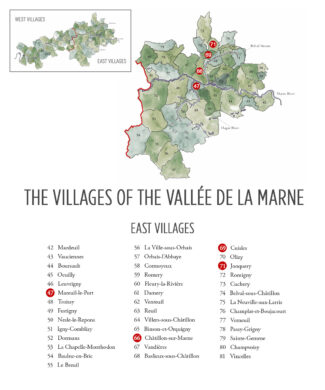
West of Châtillon-sur-Marne, chalk tends to be found more deeply buried in the ground; the topsoil is made of calcareous clay and clay marls. The combination of cold weather and rich clay makes Pinot Meunier the grape of choice in this part of the valley and it is here that a new generation of experimental winemakers is deepening their own (and by proxy) our understanding of the varietal.
Fanny & Alexandre Heucq
Champagne André Heucq
In the heart of the Marne valley is the tiny commune of Cuisles (population 150) which happens to be an epicenter for the green illite clay; it is unique to Cuisles and two surrounding villages and it is arguably the terroir where Meunier feels most at home.
According to André Heucq, who—along with his daughter Fanny— specializes in Meunier grown on fifteen acres of estate vineyards, “Green clay retains water better than chalky soils, this type of soil needs less water than classic clay-limestone soils. Generally speaking, the Marne Valley is prone to downpours of rain, and this is where Cuisles’ unique position in the hollow of the valley plays a fundamental role: Showers are much less frequent, so soil and climate are in perfect alchemy for optimum ripening of the Meunier.”
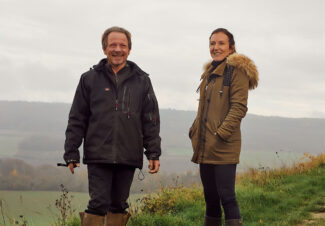
André & Fanny Heucq, Champagne André Heucq
Fanny says that the terroir, so vital to their wines’ purity and elegance, is enhanced by a commitment to biodynamics: “Production that respects the environment reactivates the vine’s natural self-defense mechanisms, allowing us to do away with the use of chemicals and use very low doses of copper and sulfur.
Among the strictest (and most interesting) of the cosmos-oriented techniques the estate relies on is the ‘500’—a preparation is obtained by fermenting good quality cow manure in the soil over the winter, introduced via cow horns. Fanny explains, “This preparation is aimed at the soil and plant roots. Its name comes from the fact that it contains over 500 million bacteria per gram. The silica from the horn is equally important. It is complementary to and acts in polarity with the 500. It is not aimed at the soil, but at the aerial part of plants during their vegetative period. It can be said to be a kind of “light spray”, which can promote vegetative vigor or, on the contrary, attenuate excessive luxuriance. It brings a luminous (crystalline) quality to plants, and reduces their tendency to disease. Not only does it reinforce the effects of sunlight, it also enables a better relationship with the cosmic periphery, with the entire cosmos. This preparation is essential for the internal structuring and development of plants. It promotes vertical plant growth. It makes plants firmer and more supple. It increases the quality and resistance of leaf and fruit epidermis.”
Views From The Right Bank: Meunier Reigns Supreme
Not only an underdog but occasionally an afterthought, growers in Champagne have often planted Meunier vines in areas that will not support the appellation’s noble couple, Chardonnay and Pinot Noir. Older vines are often found in otherwise marginalized areas, and the grape is not permitted to wear the designation ‘Grand Cru’ even if it is grown exclusively in a Grand Cru village. As a logical result of this elitism, very little Meunier is grown in Grand Cru vineyards and many producers avoid using it in their vintage wines due to its rumored inability to age—a rumor which, incidentally, is unfounded.
As in Bordeaux, the difference between the right and left banks of the region’s dominant river are striking, both in terms of vineyard exposure and soil composition. The Marne is an eastern tributary of the Seine in an area east and southeast of Paris. In Champagne, where it runs west toward Epernay, the right bank sports the valued south/southeast exposure that maximizes sun exposure and aids grape ripening. As with the Right Bank of the Dordogne River in Bordeaux, the Marne’s right bank contains more clay, making it more suited to Meunier than either Chardonnay or Pinot Noir, which may struggle to ripen in the area’s cool, frost-and-fog-prone microclimate.
 Champagne André Heucq ‘Héritage’ Blanc de Meunier, Vallée-de-la-Marne Brut Nature ($59)
Champagne André Heucq ‘Héritage’ Blanc de Meunier, Vallée-de-la-Marne Brut Nature ($59)
TCS-1 ($51)
A blend of 100% Meunier harvested in 2016/2017 from 30-year-old vines grown in illite-rich plots in Cuisles, Chatillon sur Marne, Serzy and Mareuil le Port. The wine underwent full malo and spent 48 months on lees; it was dosed to Brut Nature. The nose is nicely spiced with stewed apple and pear with notes of jasmine. A slight lemony bitterness on the finish is a mirror of the terroir. 25,000 bottles made.
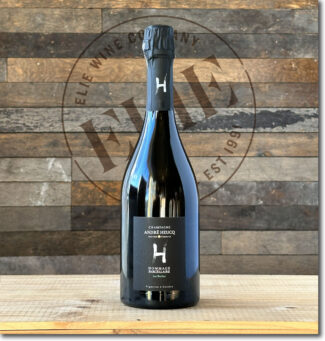 Champagne André Heucq ‘Hommage Parcellaire’, 2015 Vallée-de-la-Marne – Jonquery ‘Les Roches’ Brut Nature ($117)
Champagne André Heucq ‘Hommage Parcellaire’, 2015 Vallée-de-la-Marne – Jonquery ‘Les Roches’ Brut Nature ($117)
100% Meunier from younger vines—22 years old—grown in illite in the ‘les Roches’ lieu-dit in Jonquery. The wine is from the 2015 harvest, fermented ‘en barrique’ and aged three years on lees after undergoing full malo. Dosed to Brut Nature. The wine’s bouquet is of peach and plum with notes of pie crust and almond. The long and pronounced minerality in the finish is indeed an earthy homage to the parcel from which it arises. Only 800 bottles were made.
The Montagne de Reims: Grande, Petite, North And The Grand Vallée
Located between Reims and Épernay, the Montagne de Reims is a relatively low-lying (under a thousand feet in elevation) plateau, mostly draped in thick forest. Vines find a suitable home on the flanks, forming a horseshoe that opens to the west.
So varied are the soils, topography and microclimates here that it is not possible to speak of the region in any unified sense. Grande Montagne de Reims, which contains all of the region’s Grand Cru vineyards, covers the northern, eastern and southern slopes of the viticultural area, and Pinot Noir plantings dominate at 57%, followed by Chardonnay (30%) and Meunier (13%). Its vineyards face a multitude of directions, and soil type varies by village, giving rise to a breadth of Pinot Noir expressions, as well as exceptional Chardonnay.
To the west, the Grande Montagne de Reims gives way to the Petite, whose bedrock is chalk, but softer than the chalk found further south on the Côte des Blancs. This sort, called ‘tuffeau’, is an extremely porous, sand-rich, calcium carbonate rock similar to what is found in wine regions of the middle Loire Valley.
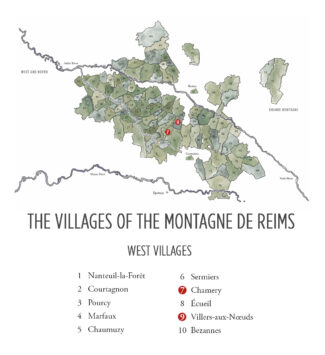
In French, the word ‘petite’ often to refers to a ‘lesser’ commodity, but with La Petite Montagne, the reference is to elevation. This lower elevation means warmer weather, even in Champagne’s northerly climate, and in certain villages, the soil contains more sand, making it an ideal environment for growing Petit Meunier.
Meunier accounts for approximately half of the plantings in the Petite Montagne, with Pinot Noir making up 35% and the rest Chardonnay. It is a growing conviction among growers of the modern era that Meunier is a Champagne grape whose time has come, especially as an age-worthy variety.
Emmanuel Brochet of Villers-aux-Noeuds says, “People claim that Meunier ages too quickly, even faster than Chardonnay. I disagree. The curve of evolution is different. Meunier is quick to open and more approachable in youth, but then it becomes quite stable. Chardonnay tends to open later, but old Meunier remains very fresh and lively.”
Olivier Langlais
Champagne Solemme
The name Solemme is a combination of ‘sol’ for the sun, with the addition of a feminine suffix. “My goal,” says cellar master Olivier Langlais, “is to make delicate Champagnes that are bright like the sun.”
La Petite Montagne-de-Reims, to the west of the road between Reims and Épernay, boasts steep slopes and chalky soils, making it the home of some of the best Premier Cru vineyards in Champagne—Savart, Brochet, Egly-Ouriet, etc. Also calling the region home is Olivier Langlais, who farms fifteen acres of organic vineyards in the terroir around Villers-Aux-Noeuds. A true exception in Champagne region, he makes wines using only the product of the harvest year.
His dedication to biodynamics and agriculture according to the cycles of the moon began with the Chardonnay plot in 2009 and finished the transition with his oldest vines of Pinot Noir in 2015. The vineyard is composed of 50% Pinot Meunier, 25% Chardonnay and 25% Pinot Noir divided between six villages—five of them Premier Cru. Most of the plots, as is the case of most Petit Montagne de Reims vines, are southeast/east oriented.
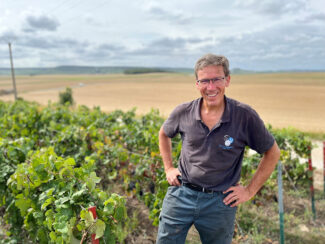
Olivier Langlais, Champagne Solemme
“Everything is happening in the exchange between the soil and the grape”, Olivier points out. “That’s why the difference of terroir between all parcels determines variety and process. Villers-aux-Noeuds has a classic chalky soil, bringing a lot of minerality to the Chardonnay and Meunier growing there. Clay-limestone dominates Chamery and Vrigny, with a bit more clay in Vrigny, where Meunier gets better results—clay gives more ‘gras’, or roundness to the grapes. Often not mentioned is the sandy soils of Villedomange and Eceuil, which gives Pinot Noir a concentrated and elegant form.”
Once in the cellar, Olivier is a champion of a hands-off approach. He never chaptalizes and uses only natural yeast from his vineyard. “In the chai, you won’t find any barrels,” he says. “We do not filter, there is no addition of SO2 and all the cuvées spend between 36 to 48 months on the lees as a means of better expressing the terroir. 90% of the time, I don’t do any malolactic fermentation, because I prefer to let the natural minerality shine.”
Transformation in The Petite Montagne: Meunier Shares Space With Pinot Noir
The western portion of the Montagne de Reim—the so-called Petite Montagne—stretches from Gueux in the north to Sermiers in the south, on the western side of the main road that runs between Epernay and Reims. Although this region has a historical fondness for Meunier, some acres have been replanted to Pinot Noir in recent years, potentially doing a disservice to the vineyards north of Écueil in the villages of as Sacy, Villedomange, Jouy-lès-Reims, Coulommes-la-Montagne, Vrigny and Gueux. But the soils here are generally more overtly calcareous than those in the Vallée de la Marne and can contain a high proportion of fossils. In Écueil, there is sand on the lower slopes, acting as a defense against phylloxera, allowing some growers to plant Pinot Noir on the original rootstocks, so this becomes the cultivar of choice.
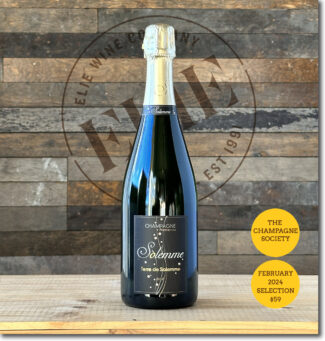 Champagne Solemme ‘Terre de Solemme’, Montagne-de-Reims Premier Cru Villers-aux-Nœuds Brut (68)
Champagne Solemme ‘Terre de Solemme’, Montagne-de-Reims Premier Cru Villers-aux-Nœuds Brut (68)
TCS-2 ($59)
Villers-aux-Nœuds is a Premier Cru village in Vesle et Ardre; about half the vineyards are planted to Pinot Noir, with Meunier making up about 30%, and the rest, Chardonnay. Olivier Langlais farms fifteen acres here; the land is relentless hilly and the soil is made up of Cretaceous chalk under a few inches of ‘argilo-calcaire’ topsoil. Disgorged according to the moon cycle (a feature of his brand of biodynamics), ‘Terre Solemme’ is a blend of 55% Meunier, 25% Pinot Noir, and 20% Chardonnay aged three years on the lees. Buttery toast on the nose along with cooked apple and cantaloupe. The palate has an echo of the nose and a nice marzipan richness that drives the mineral finish home.
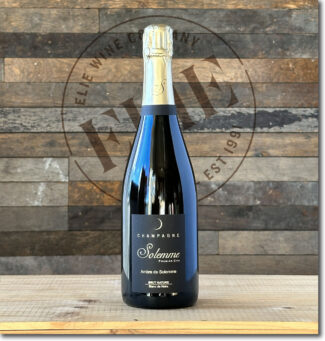 Champagne Solemme ‘Ambre de Solemme’, 2016 Montagne-de-Reims Premier Cru Villers-aux-Nœuds ‘La Motelle’ Blanc de Noirs Brut Nature ($99)
Champagne Solemme ‘Ambre de Solemme’, 2016 Montagne-de-Reims Premier Cru Villers-aux-Nœuds ‘La Motelle’ Blanc de Noirs Brut Nature ($99)
100% Meunier from the ‘La Motelle’ lieu-dit, filled with 50-year-old Massal-selected vines; these grapes were harvested somewhat late and developed a spectacular ripeness. ‘Ambre’ refers to the color, whose slight tint is the result of skin-contact. The nose sets out with fresh apple and a touch of grapefruit and strawberry coming out, with bold acidity reflected in a spine of salinity that balances an otherwise rich and creamy wine.
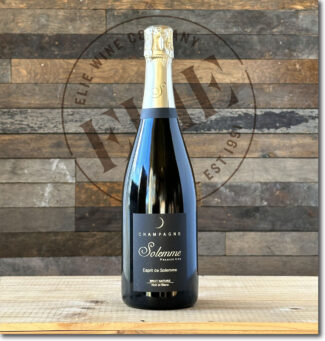 Champagne Solemme ‘Esprit de Solemme’, 2018 Montagne-de-Reims Premier Cru Brut Nature ($79)
Champagne Solemme ‘Esprit de Solemme’, 2018 Montagne-de-Reims Premier Cru Brut Nature ($79)
2018 was an excellent vintage in Champagne; the crop was large and healthy, rich in sugar and flavor depth, with all three major grape varieties performing well. ‘Esprit de Solemme’, 2018, is equal parts Pinot Meunier and Chardonnay drawn from chalky soil in Villers-aux-Nœuds and the clay-limestone hillsides of Chamery. This cuvée shows a lovely bouquet: cream, biscuits, pineapple and toasted nuts. The palate is very dry but stays in balance with cream and salinity through the finish.
Notebook ….
Drawing The Boundaries of The Champagne Region
Having been defined and delimited by laws passed in 1927, the geography of Champagne is easily explained in a paragraph, but it takes a lifetime to understand it.
Ninety-three miles east of Paris, Champagne’s production zone spreads across 319 villages and encompasses roughly 85,000 acres. 17 of those villages have a legal entitlement to Grand Cru ranking, while 42 may label their bottles ‘Premier Cru.’ Four main growing areas (Montagne de Reims, Vallée de la Marne, the Côte des Blancs and the Côte des Bar) encompass nearly 280,000 individual plots of vines, each measuring a little over one thousand square feet.
The lauded wine writer Peter Liem expands the number of sub-regions from four to seven, dividing the Vallée de la Marne into the Grand Vallée and the Vallée de la Marne; adding the Coteaux Sud d’Épernay and combining the disparate zones between the heart of Champagne and Côte de Bar into a single sub-zone.

Lying beyond even Liem’s overview is a permutation of particulars; there are nearly as many micro-terroirs in Champagne as there are vineyard plots. Climate, subsoil and elevation are immutable; the talent, philosophies and techniques of the growers and producers are not. Ideally, every plot is worked according to its individual profile to establish a stamp of origin, creating unique wines that compliment or contrast when final cuvées are created.
Champagne is predominantly made up of relatively flat countryside where cereal grain is the agricultural mainstay. Gently undulating hills are higher and more pronounced in the north, near the Ardennes, and in the south, an area known as the Plateau de Langres, and the most renowned vineyards lie on the chalky hills to the southwest of Reims and around the town of Épernay. Moderately steep terrain creates ideal vineyard sites by combining the superb drainage characteristic of chalky soils with excellent sun exposure, especially on south and east facing slopes.
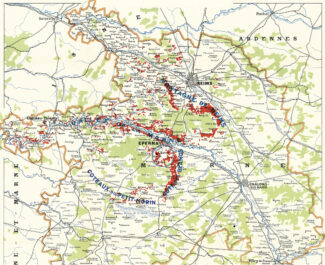
Single Harvest vs. Vintage
In France, under Appellation d’Origine Contrôlée (AOC) rules, vintage Champagnes must be aged for three years—more than twice the required aging time for NV Champagne. The additional years on the yeast is said to add complexity and texture to the finished wine, and the price commanded by Vintage Champagne may in part be accounted for by the cellar space the wine takes up while aging.
On the other hand, a Champagne maker might prefer to release wine from a single vintage without the aging requirement; the freshness inherent in non-vintage Champagnes is one of its effervescent highlights. In this case, the wine label may announce the year, but the Champagne itself is referred to as ‘Single Harvest’ rather than ‘Vintage’.
- - -
Posted on 2024.02.01 in France, The Champagne Society, Champagne | Read more...
The Paradox of Chenin: Three Neo-vignerons Use The Variety To Explore Anjou Noir’s Microclimates And Soil Complexity With Unique Collection Of Grand Crus And Single-plots
Chenin shares some traits with Marilyn Monroe; it’s blonde, beautiful, rather dreamy and frisky… and, of course, it’s easily exploited. Chenin certainly has a tawdry side (the generic jugs—no pun—from Gallo, circa the 1970s), but when allowed to shine—as Monroe did in ‘Gentlemen Prefer Blondes’—it becomes a classic icon; a phenomenon and galaxy unto itself.
Monroe reinvented herself when needed, going from cheesy pinup fodder to a Time Magazine cover icon in a dozen years. In the Loire, spiritual home to Chenin since the 15th century, a new generation of trailblazers (both neo-vignerons and heirs of historic properties) are introducing a similar evolution in style and substance, extending the range of high-quality, age-worthy dry Chenin into areas where schist, rather than limestone, form the growing medium.
It’s fair to say that Chenin’s reputation in the Loire has been largely built on its ability to produce unique sweet wines—mouthwatering, luscious examples can be found throughout the Middle Loire, particularly in Quarts-de-Chaume and Bonnezeaux (two enclaves within the Coteaux du Layon) and in the twin appellations of Vouvray and Montlouis-sur-Loire. These wines are generally the result of botrytis, to which the region’s climate is susceptible and enhanced by the fact that harvest is often not until November, by which time the grapes have had plenty of hang time to develop natural sugars. This may be further encouraged by allowing the bunches to dry on the vine, and some undergo the process known as ‘passerillage’ wherein they are dried after harvest.
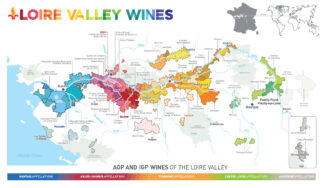
Of course, dry Chenin has always had its niche and its loyalists—nowhere more prominently than in Savennières. Falling within the wider Anjou district, the appellation once had a prominent seat on the sweet wine bandwagon, but in the latter decades of the 20th century producers began specializing in the drier styles for which Savennières is known today, standing proudly as the only dry white appellation in Anjou’s sugary sea.
Some may like it hot, but with a slight chill, there are few white wines that offer more in terms of sensuous oomph and hedonistic delight, and this week, we’ll take a look at some of the upstarts in the region, with a focus on Anjou and Savennières and an overview of the botrytis phenomenon and how it gilds the sugar lily.
The Package: Six Wines For $299
This week’s package offering is comprised of two bottles from each domain for a total of six bottles at $299. The selected wines are numbered and, also, indicated in the write-up about the wine.
Anjou Noir: A Collection of Soils With Chiseled Character
Lest we go overboard with the oxymoron ‘Anjou Noir’, the varietal in question is white, the wine is white (with golden tints) and even the botrytis is sort of white. It’s the soil of the region (in the western part of Anjou, toward Brittany), veined with black charcoal from forests 500 million years old, that earned Anjou Noir its name.
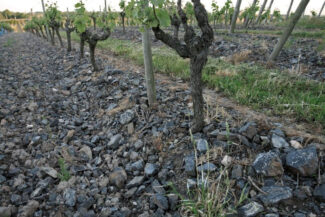
Anjou Noir, a land of Schists (Château d’Epiré, Photo by Philippe Caharel)
Highbrow terroir experts refer to this soil as ‘metamorphic schistous’ and it is among the oldest soil in France—a plus, since the rock base has had plenty of time to degrade and weather into usable minerality. In addition, the slopes of Layon are on a fault-line that appeared during the creation of the Alps and resulted in a multitude of microclimates based on the proximity of rivers and hillsides. The region lays claim to a wide variety of soils—sandy clay on plateaus, slopes of purple and gray schist crossed by veins of volcanic rock, and all flavors in between. Dark schist rocks are a chromatic contrast to the white tuffeau found in eastern Anjou, and nowhere is this displayed more strikingly in the medieval ‘striped’ castles of Angers, Anjou’s capital, which used both for construction.
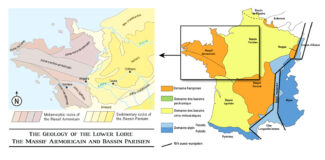
One vinous advantage of this ancient, undulating landscape is the creation of multiple individual spots with particularly advantageous terroir. Called ‘climats’ in Burgundy and lieux-dits elsewhere, these are the source for the plot-specific wine of which the maverick new wave of vigneron in Anjou are enamored.
The Protean Dry Chenin: Transparent Expression
Chenin can produce some neutral and forgettable wines, and that is self-evident in the Central Valley bulk stuff that California has produced over the years. In such styles, chaptalized sweetness is done for more than customer appeal; it hides various flaws inherent to substandard farming. Of course, there is little excuse for flawed wine using today’s craft and to be sure, the sweet wines of the Loire are examples of the highest art of concentrated grape sugars, capable of aging and improving for decades—in part because sugar also acts as a preservative.
Creating a dry wine that can improve with years in the bottle is a tougher nut to crack, especially if no oak—also a preservative—is not used. This is where Chenin’s other natural propensity comes into play: Acidity. In Burgundy, Chablis—with or without oak—is well known for its longevity, caused in part by the acidity that Chardonnay displays when grown in chalky soil. Chenin puts on the same razor-sharp pageantry when grown in schist, and like Chardonnay, it is a variety that echoes terroir transparently, and as such, too much oak or added sweetness may work against this inherent expression.
Is there a downside? Undoubtedly. With very young Chablis, the steely bite of immature acid may be unpleasant, and many require a few bottle years to mellow toward splendor. Whereas Chenin is filled with lovely and complex flavors young, the ‘brut zero’ versions require about the same length of time to veer toward their peak.
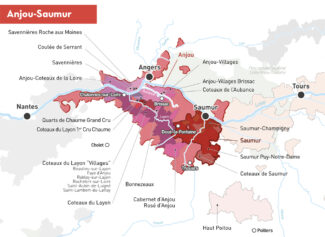
Savennières: Chenin For Thought
Savennières is as small an appellation as its wines are big. It is the the Loire Valley AOP where Sauvignon Blanc yields ground to Chenin—the only variety legally allowed in this tiny (fewer than four hundred acres) appellation.
We likened Savennières Chenin to Chablis Chardonnay above; a correlation can also be drawn with German Riesling. Capable of producing unctuous sweet wines, it also shows a keen, mineral-tinged profile when dry, both capable of years—even decades—of bottle growth given the right vintage and the right cellaring conditions. And it remains a bit of a secret: Even with two remarkable sub-appellations, La Rouche aux Moines and the monopole La Coulée de Serrant facing south along the Loire River, the appellation does not get much glad-handing by trade and consumer press. This may be seen as a marked contrast between the ballyhood Vouvrays from further east in Touraine. That’s generally because even age-worthy Vouvray is easier-going and more accessible when young, grown on soils of clay and tuffeau (a form of limestone) as well as flinty silex. In Savennières, the vineyards are largely built on schist, sandstone and rhyolite (a volcanic rock) and in their youth, Savennières can have the jolting sizzle of austerity.
In part, of course, Savennières’ under-the-radar status is its own doing. Historically, growers have tended to produce wines reductively, harvesting their grapes with a potential alcohol of 12º, picking them when they were still green in color. These practices resulted in rather backward wines which, for the most part, came to define Savennières’ ‘typicity.’ True, with a decade in the bottle, this style of wine can show great depth and elegance, but you have to be a particularly knowledgeable and patient consumer to go through these steps to wind up with an enjoyable wine.
… Which is why the new guard of winemaker has begun to make changes in Savennières, and perhaps most emblematic of this is Domaine Laureau. With bottle age, these are among the most elegant expression of Chenin to find today, oozing with honey, acacia and ripe apples.
Domaine Laureau
Every winemaker in Savennières would probably like to be referred to as ‘… undoubtedly, the future star of the appellation’ by ‘La Revue de Vin de France’ but it only happened to one: Damien Laureau, working out of a small shed in Epiré, nine miles southwest of Angers, and cultivating 15 acres of Chenin in Savennières and Savennières Roche-aux-Moines. Along with his wife Florence, he considers himself an ‘agricultural engineer’ whose promise to the alliance they have formed with nature is to reflect ‘the earth in light.’
Part of this alliance involves using fruit extracts and other non-synthetic treatments on the vines in place of harsh chemicals, and allowing wildlife and indigenous plants to share space with the Chenin. Like a few other area growers, Damien is starting to experiment with harvesting when the grapes turn yellow (instead of the traditional Savennières ‘green grape’ stage) to take advantage of the richness of the sun—the ‘earth in light’. At the same time, he is careful not to pick late in order to avoid the high levels botrytis to which the region is prone. Relying on low yields (an average of 35 hectoliter/hactare is quite common) his wines are emblematic of beautifully balanced dry wines for which Savennières is increasingly known, built around richness, concentration, lively acidity and length.
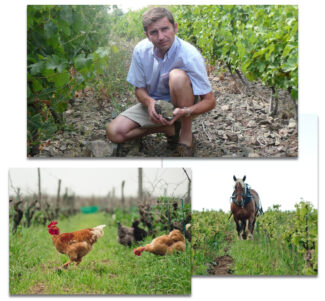
Damien Laureau, Domaine Laureau
“We put our know-how to work for the benefit of terroir,” Damien maintains. “All vineyard treatments and work in the cellar is organic; we have been ECOCERT certified since 2012. We are a microscopic domain compared to many—we have two employees, Patrick and Aurélien, who put all their energy into the daily manual work, delicately and carefully, close to the vine. In the cellar, our wines are aged simply, in barrels, tanks or jars. No filtration is allowed, to keep the wines nicely aromatic and well-structured.”
Florence adds: “The grapes are harvested by successive selections, pressed directly, settled for 12 hours, and put in fermentation (indigenous yeasts) for sometimes a year, in vats or in barrels depending on the terroir. Each micro-terroir is identified and vinified separately. The wines are aged on lees for 18 to 24 months allowing the wine to acquire roundness, complexity and charm. The character of the chenin and the terroir are respected by a gentle, long and non-interventionist breeding.”
 •Bottle1•
•Bottle1•
Domaine Laureau ‘L’Alliance’, 2022 Savennières ($32)
The alliance referred to in the wine’s name is between small parcels of younger vines, including the lieux-dits La Petite Roche and Pitrouillet, that Damien himself planted on sandy grey schist between ten and twenty years ago. These vines have been farmed organically from the start, worked by hand, and plowed by horse. Damien Laureau selects the lightest and freshest musts at the time of pressing to create a wine, though able to age, that is ideal for consumption in its youth. The wine spends ten months in tank on the fine lees and is bottled unfined and unfiltered; it shows sweet apple and pear, a touch of Angostura bitters and wormwood behind a minerality that is not as steely as some young Savennières.
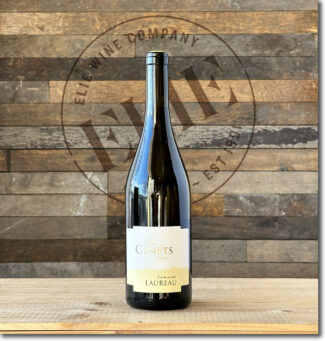 •Bottle 2•
•Bottle 2•
Domaine Laureau ‘Les Genêts’, 2020 Savennières ($50)
Genêts, named for the yellow flowering broom plant, is another firm and textured wine that can be enjoyed in its youth. In part, this is because the vineyards clustered around the Moulin de Beaupréau at the far northern edge of the appellation host a light, sandy terroir of schist and phtanite, and produce wines that are high in acidity, but round on the palate. This is further enhanced by a year in large oak casks, then six months in tank before bottling. It shows pronounced Anjou pear on the nose along with magnolia and Macadamia nuts, and an elongated and pure finish where the acid is embracing rather than shocking.
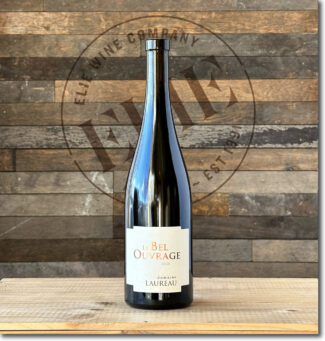 Domaine Laureau ‘Le Bel Ouvrage’, 2020 Savennières ($64)
Domaine Laureau ‘Le Bel Ouvrage’, 2020 Savennières ($64)
Le Bel Ouvrage (‘Nice Piece of Work’) is a wine that reflects a trio of terroirs in La Petite Roche, a vineyard in eastern Savennières near Laureau’s home-base village of Epiré. Soils here are largely grey schist and rhyolite and produce wines that may seem a bit clumsy when young, but evolve to offer sweet and savory notes of peach jelly and butter-rich pastry. The wine shows rich phenolic texture and focused acidity, enhanced in part because, in 2016, Laureau stopped malolactic fermentation in his wines.
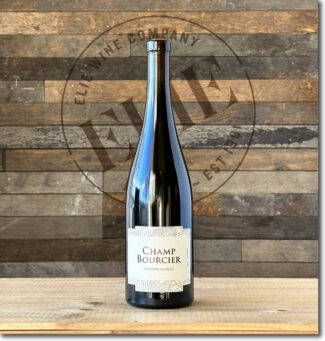 Domaine Laureau ‘Champs Bourcier’, 2019 Savennières ($108)
Domaine Laureau ‘Champs Bourcier’, 2019 Savennières ($108)
This is an interesting, weather-driven cuvée born of the 2019 vintage, which so compromised the production of ‘Le Bel Ouvrage’ that Laureau bottled from his father’s old vineyard instead. ‘Bel Ouvrage’ is a cuvée name, not a lieu-dit, but ‘Champ Bourcier’ is a vineyard plot rich in rhyolite—magmatic rock woven through with threads of micro-granite. The wine sees 30 months aging on the lees, including 12 months in 400 liter oak barrels and 18 months in 1200 liter sandstone jars; the profile shows crisp green apple, honeyed pear counterbalanced by a revitalizing undercurrent of acidity.
Anjou: Chenin At Large
As is the case in Burgundy and Bordeaux, the catchment called ‘Anjou’ is a regional appellation that encompasses a very wide region in the Loire, and is subject to a set of regulations far less restrictive than those for the sub-appellations we have singled out here. For one think, it does not even require Chenin whites to be pure Chenin, and many are not; up to 20% Sauvignon Blanc and Chardonnay is permitted by law.
The Anjou AOP also covers red wine made from Gamay and sparkling wines, although rosé is covered under two separate appellations, ‘Rosé d’Anjou’ and ‘Cabernet d’Anjou.’
Chenin, the focus of our package this week, does exceptionally well in Anjou, in part because of its chameleon-like tendency to step up to the plate in essentially any weather pattern and alter its profile to suit the mood of the day. In dry weather, it can produce excellent white and sparkling wines; at moderate humidity levels, whether due to the autumn fog or the influence of the ocean, it creates sweet, semi-dry, and dessert wine. It is a grape capable of taking on the profile of its terroir almost seamlessly, and allows its personality to mesh with its place—the French wine philosophy made manifest.
Terre de l’Élu
For Charlotte and Thomas Carsin, winemaking is many things—an interest, then a passion, then a commitment, then a profession. But first and foremost, it’s an adventure.
“My path to Clos de l’Élu began as a grape picker in Burgundy,” Thomas shares. “I was studying tropical agronomy, but ultimately chose to specialize in wine and found work placements in Sonoma, where I learned a great deal about terroir and vinification.”
After that, he learned the retail side of the business in a Paris boutique and spent five years doing consultancy work in Champagne. By the time his stint as a journeyman was over, he had learned a very keen lesson about the ‘over-engineered wine industry’: He hated it. By then he was well-versed in ‘winegrowing empiricism’—the language of the vines and master the idea of terroir. He spent a few more years making wine in Provence, in the departmente of Var, but it wasn’t until 2008 that he was able to acquire a domain and produce wine on his own terms: “Acquiring Clos de l’Élu, in the heart of the Layon valley, was a dream come true.”
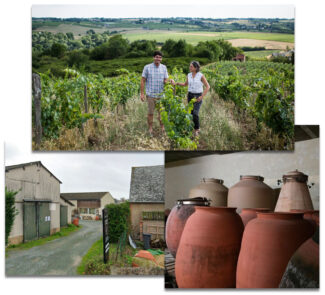
Thomas and Charlotte Carsin, Terre de l’Élu
Charlotte’s road to the winery was a bit more straightforward. Having worked in communication, with specialized interest in pairing food and wine, she has learned the technical angles hands-on. Of course, her professional chops allow her to serve as the winery’s administrator, in the sales and marketing of the winery, and especially brand image, packaging, events, and communication methods.
As to the estate, Terre de l’Élu is in Saint-Aubin de Luigné; the vines grow on the outskirts of the village between Chaume and Ardenay, on the right, south-facing side of the Layon River. Soils here are classic Anjou Noir, full of volcanic rocks, sandstone and quartz.
* A Note on de l’Élu’s ‘VdF’ label status: The domain was originally called Clos de L’Elu, but in 2018, frustrated by politics and arbitrary restrictions of the Anjou appellation, they decided to leave the AOP. This meant more freedom to grow the grapes they wanted and vinify them as they wished, but also necessitated a name change, as they were no longer allowed to us any word referencing the location – including their famous walled Clos. So the domain became Terre de l’Élu, the wines were labeled Vin de France, and a new era of experimentation and creativity began. Thomas affirms their decision in saying, “What counts the most is to make the wine of the terroir.”
 •Bottle 3•
•Bottle 3•
Terre de l’Élu ‘Bastingage’, 2021 VdF Loire-Anjou ‘Chenin’ ($32)
Bastingage is Terre de l’Élu’s flagship wine, and the term fits since a bastingage is the railing that surrounds a ship’s deck. The grapes come from three parcels, Les Barres, L’Aiglerie and Chaumes, vinified separately and combined only at the final assemblage. The grapes are hand-harvested with meticulous sorting done in the vineyard using multiple passes followed by slow, direct pressing and natural fermentation on native yeast. The wine spends one year on lees, then in blending vats for another three months. It shows the superb minerality that is typical of schist terroirs, but it is soften by ripe tones of citrus and candied apple.
 •Bottle 4•
•Bottle 4•
Terre de l’Élu ‘Ephate’, 2019 VdF Loire-Anjou ‘Chenin’ ($73)
‘Ephata’ means ‘be opened’ in Greek, although you can resist this directive for many years and not be disappointed. The wine is among those built for the long haul, with aggressive acidity and a tannic-like quality. The grapes come from 70-year-old vines with a ludicrously low yield of 20 hectoliter/hectare. Grapes are hand-harvested and gently pressed, then allowed natural fermentation for six months in 1000 liter sandstone amphorae, followed by one year in 1400 liter terracotta amphorae with ouillage (topping off) done every two months. This is followed by another 6 months back in the 1000 liter sandstone amphorae. The wine is smooth and complex with notes of damp stone and ripe pear with slight spice hints of anise and angelica.
Domaine Belargus
Many French wineries trace their origins back centuries. The owner of Belargus (named for the colorful butterfly that flits about the estate) plays an even longer game: “This began in the earliest hours of earth,” says Ivan Massonnat. “Over hundreds of millions of years, the Armorican Massif eroded into hillsides—terrestrial islets with complex geography, and between the Loire and Layon rivers, Anjou wine was born … and in its wake, Belargus.”
Few vignerons in Anjou are as determined to explore the region’s myriad possibilities as Massonnat—the domain is a collection of Grand Crus, single-plots, monopoles and micro-climates, using Chenin as the sole instrument. “Our vines are distributed around three main islets (Savennières, Quarts-de-Chaume and the Layon Valley), themselves composed of singular terroirs, each precisely defined by their exposure, their subsoil or their slope.”
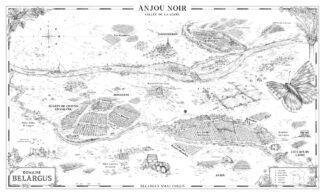
This musical mosaic of terroirs is expressed through a collection of cuvées that highlight three main islets, Savennières, Quarts-de-Chaume and the Layon Valley. Says Massonnat: “We employ a single-plot approach inspired by the climats of Burgundy. Among our most remarkable terroirs is the Grand Cru Quarts-de-Chaume, the estate’s center of gravity with twenty-six acres in one piece. Our first monopole is Coteau des Treilles, a wild and steep hillside located in the heart of a classified Regional Natural Reserve; our second is Clos des Ruchères in Savennières, planted on a rare hillside of purple schists.”
Massonnat is as beholden to vintage as to terroir, and every year, through respect of the same, he produces dry white wines, but in exceptional years, he relies on the magic of botrytis to create sweet wines.
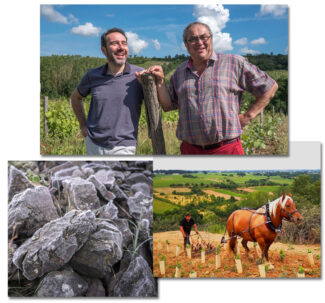
Ivan Massonnat and Jo Pithon, Domaine Belargus
He’s also sold on the virtues of the collective approach, and since its inception, he has brought together young talents like winemaker Adrien Moreau and vineyard manager Amaury Chartier along with some iconic Loire pioneers like Jo Pithon and Guy Bossard. This faith in collective energy has seen Massonnat preside over the international Anjou festival called Paulée d’Anjou and spearheading a tireless struggle to get ‘Ronceray’ officially recognized as a Cru.
“Belargus is a 100-year project.,” Massonnat says. “Everything we do, we have that horizon.”
 •Bottle 5•
•Bottle 5•
Domaine Belargus ‘Ronceray’, 2020 Anjou Blanc ($71)
Ronceray is the name coined by Chaume growers to describe dry Chenin made in this sweet-only appellation, which is why the declassification of the 100% Chaume fruit—named, ironically, for a 17th century monastery that made dry wines on the Chaume hill long before it became an officially-mandated appellation for sweet wine. From 30-year-old vines grown in loamy clay, schist, sandstone and puddingstone, the wine is an exotic array of aromas ranging from candied mango and warm hay to quinine and barley.
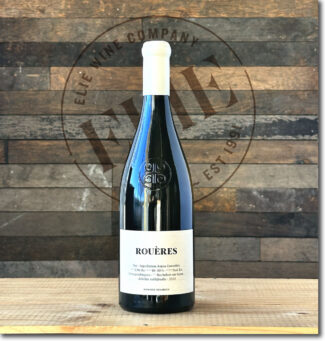 Domaine Belargus ‘Rouères’, 2020 Anjou Blanc ($108)
Domaine Belargus ‘Rouères’, 2020 Anjou Blanc ($108)
Les Rouères is an east and southeast-facing lieu-dit in Quarts-de-Chaume, where the soils are dominated by puddingstone rather than schist. This soil type is a naturally loose conglomerate with various sizes notable for radiating daytime heat well into the evening, so while this site might not have the warmest exposure in Quarts-de-Chaume, the terroir makes up for it. Domain Belargus owns a little over seven acres of vines in this lieu-dit and makes two cuvées—this dry wine wears the Anjou appellation and a late-harvest Quarts de Chaume. The dry version is intensely aromatic with peach compote and apple butter intertwined with delicate mineral notes, structured to improve for a decade or more.
 Domaine Belargus ‘Veau’, 2020 Anjou Blanc ($126)
Domaine Belargus ‘Veau’, 2020 Anjou Blanc ($126)
Says Ivan Massonnat: “Le Veau is one of the three plots originally listed in the decree creating the Quarts-de-Chaume appellation. Our plot covers the most part of this small area, exposed to the west. Its name comes from the shape of the plot, which constitutes a small valley where the soil is very thin—non-existent in some parts—as the plot rests on a flush schist area, providing mineral tension and long aging potential to the wine.”
First produced in 2019, the cuvée is aged in vats and barrels for a minimum of one year and represents the quintessence of Chenin cultivated on black schist. It exhibits subtle purity and refreshing minerality blended with quince, apple skin and honey followed by a lingering tannin grip and salinity.
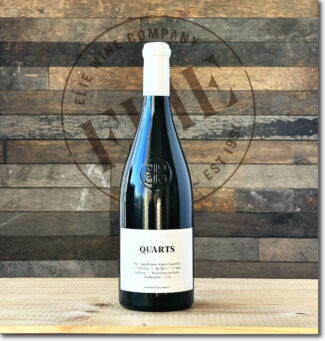 Domaine Belargus ‘Quarts’, 2020 Anjou Blanc ($144)
Domaine Belargus ‘Quarts’, 2020 Anjou Blanc ($144)
‘Les Quarts’ is the lieu-dit from which the Quarts-de-Chaume appellation draws its name. In fact, until the French revolution stopped all that elitist stuff, the lords of Haute-Guerche (who farmed the vineyard) paid the Ronceray Abbey with ‘the best quarter of the harvest’ or, the ‘Quarts-de-Chaume.’ Massonnat’s portion is about half the 20-acre vineyard, with southern exposures, where the soil is predominantly Precambrian schist. This comes through in the crystalline purity of the bouquet, calling to mind peach candy, crushed stone and lightly-salted grapefruit sections.
Coteaux-du-Layon: The Magic Of Botrytis Creates Sweet Chenin
You say botrytis, I say noble rot (the Germans say edelfäule and the Hungarians, aszúsodás) but fair to say, nobody is going to call the whole thing off … except Mother Nature. As most students of the vine know, botrytis is a beneficial form of grey fungus that forms late in the season in certain areas when weather conditions are right—humid, damp, but not too damp, then followed by a dry spell. Grapes thus affected become raisined, produce concentrated wines that are among the most opulent, expansive and hedonistic wine in the world. Included in the list of botrytised wines are the Sélection de Grains Nobles of Alsace, Germany’s sweeter styles, Sauternes in Bordeaux and Tokaji in Hungary.
And, of course, the honeyed gems of the Loire. Coteaux-du-Layon is not the only sweet wine appellation in Anjou, but it is the biggest, encompassing 27 communes to the south of Angers, accounting for roughly 4,200 acres of vineyards. No fancy-pants blends here—all Coteaux-du-Layon wines are made from Chenin.
The region’s reputation for sweet wines is due in large part to its topography, the result of the local river systems, including the Layon, which has carved out south-facing slopes and sheltered mesoclimates protected from the cold continental winds that blow in from the north and east. The botrytis, so indispensable for the wine, is the result of morning mist rising from the rivers. As is the case with German wines, the sweetest wines of the Coteaux are also the most expensive and labor intensive. They are made from grapes harvested in multiple passes through the vineyard, with pickers collecting only grapes affected by noble rot.
 •Bottle 6•
•Bottle 6•
Domaine Belargus ‘Layon’, 2018 Coteaux-du-Layon ($42) 375 ml
Another interpretation of Chenin from south-facing, schistous slopes above the Layon River. Radiant orange in color and brilliantly alive with apricots intertwined with fresh ginger and beeswax, this is a seamless moelleux with fine crystalline structure and the refreshing balance of acidity.
 Domaine Belargus ‘Écharderie’, 2018 Coteaux-du-Layon Premier Cru Chaume ($108)
Domaine Belargus ‘Écharderie’, 2018 Coteaux-du-Layon Premier Cru Chaume ($108)
Écharderie is a southwestern-facing lieu-dit that stands in the spot where the cellars of the seigneurs de la Haute-Guerche were once located. Domaine Belargus farms slightly under an acre of Chenin in this Chaume Premier Cru, planted on a mix of schist, alterite and puddingstone soils. The wine shows light marzipan, dried apricot, honeysuckle and sweetened green tea that shine through to an electrifyingly acid and salty-sweet finish.
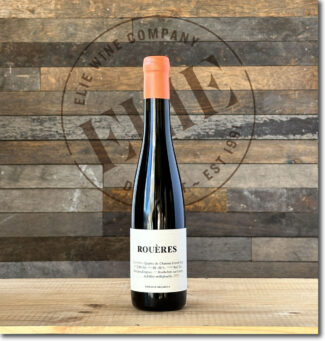 Domaine Belargus ‘Les Rouéres’, 2018 Quarts-de-Chaume Grand Cru ($126) 375 ml
Domaine Belargus ‘Les Rouéres’, 2018 Quarts-de-Chaume Grand Cru ($126) 375 ml
‘Les Rouères’ is one of the three plots originally listed in the decree that created the Grand Cru Quarts-de-Chaume appellation. “Our plot covers nearly three hectares (7.4 Acres),” says Ivan Massonnat, “exposed on the southeastern slope of the rump of Quarts-de-Chaume where the puddingstone soils give a spherical and solar character to the wine. The magic the terroir when exposed to the morning mists of the Layon and aerated by constant winds results in a botrytis of rare concentration.”
This is a sweet and honeyed wine, juicy with candied lemon rind and orange marmalade caught in a noble web of botrytis.
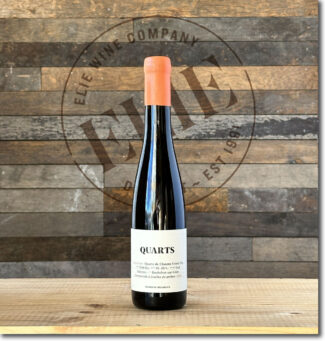 Domaine Belargus ‘Les Quarts’, 2018 Quarts-de-Chaume Grand Cru ($144) 375 ml
Domaine Belargus ‘Les Quarts’, 2018 Quarts-de-Chaume Grand Cru ($144) 375 ml
Like Les Rouères, Les Quarts Grand Cru is only made in exceptional vintages like 2018, where favorable weather conditions throughout the year yielded concentrated wines a bit lower in acidity than usual. This is a full, unctuous wine with significant aging potential; it shows gingerbread, balsamic apricot and nougat with earthy minerality and a long, bright finish.

- - -
Posted on 2024.01.26 in Savennières, Coteaux-du-Layon, Quarts-de-Chaume, France, Wine-Aid Packages, Loire | Read more...
Isabel Ferrando’s Châteauneuf-du-Pape Old-Vine Grenache Is “The Heart Of Our Vineyards And The Soul Of Our Wine” (6-Bottle Assortment $329) + Recent Arrival Châteauneuf-du-Pape Vintage 2021, Seven Wines
To Blend or Not to Blend
The magic of the blend is the keystone in Châteauneuf-du-Pape’s rock-solid reputation; fifteen varieties are legally permitted in the appellation, and the proportion of each used in the final cuvée is a reflection of the vineyard’s potential, the estate’s philosophy and the vigneron’s artistry. The palette is juice, the canvas is the élevage and on opening day, and many years to come, the exhibition wears the familiar embossed insignia of a Châteauneuf-du-Pape bottle.
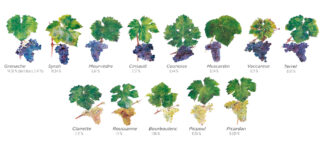
But is blending always the goal? Red wine comprises 95% of Châteauneuf-du-Pape’s output, and most of it is built around the Big Four—Grenache, Syrah, Mourvèdre and more recently, Cinsault. But as a quartet, they are hardly equal: As of 2014, 73% of the vineyards in the appellation were planted to Grenache, with Mourvèdre making up about 7% and Syrah, just under three percent—a number that may soon be supplanted by Cinsault as Syrah continues to lose popularity in the region. Even so, so dominant is Grenache in most blends that a winemaker would likely have to provide a vivisection of varietal profiles to explain how each trace addition affects the final cuvée. The blending spectrum in Châteauneuf-du-Pape, therefore, covers extremes: Château de Beaucastel frequently uses all the allowable grapes in their cuvée while another of Châteauneuf’s most important names, Château Rayas, uses only Grenache.
The Grenache
Despite its potential for splendor in the glass, Grenache has never made the leap into the rarified atmosphere of ‘noble grapes.’ But in the right hands, grown in the correct lieu-dit and farmed correctly, it can be as expressive of terroir as Pinot Noir and as complex and age-worthy as Cabernet Sauvignon. In Châteauneuf-du-Pape, it produces most favorably on sandy soils that provide delicacy and finesse, but where there is also limestone for structure, red clay for the development of rich (but not harsh) tannins and the small stones known as ‘galets’ for power. For a grape that produces such bold and muscular wines, Grenache is thin-skinned and not overly acidic, so it must be picked at an optimum period of phenolic ripeness to avoid becoming flabby and overly alcoholic. Vine age is of extreme importance for Grenache, with younger cultivars making pale-colored and often mediocre wines—60 -100 years appears to be an ideal age for the production of wine of consistently good quality.
The Grenachiste
Isabel Ferrando
If a Grenachiste is a loyalist who fights for Grenache, it would be hard to find a High Priestess more qualified than Isabel Ferrando. A former banker, she learned winemaking at Domaine Raspail-Ay in Gigondas deepened by the tutelage of the late legendary winemaker Henri Bonneau, and in 2003, purchased the seventy-year old Domaine Saint-Préfert from the Serre family, one of the region’s first domains to estate bottle. That year, the property stood at a little over thirty acres, all in the Les Serres lieu-dit south of the village of Châteauneuf.

Isabel Ferrando, Domaine Saint Préfert
Once a successful first vintage was in the cellar, Ferrando began to purchase more land in CdP, expanding her holdings to its current 55 acres. Among her acquisitions was a small parcel of old-vine Grenache vines that became Domaine Isabel Ferrando ‘Colombis.’ Meanwhile, in 2013, Domaine Saint Préfert earned its certification for using 100% biodynamic farming, an agricultural technique that is somewhat easier pull off in Châteauneuf thanks to the sporadic but predictable Mistral winds that naturally protect vines from pests and mildew.
Still, it is Ferrando’s ever-growing expertise and hands-on winemaking that produces her outstanding portfolio. Says ‘The Grenachiste’: “There is no secret formula to making great wines in Châteauneuf. I work with a young team who is always open to new ideas. We rely on tradition without being trapped by it, working with whole-cluster fermentations without added yeasts because we discovered that it increased freshness in the wines and lowered alcohol, giving the wines vibrancy. Aging occurs in a mix of concrete and used foudres for up to 18 months.”
 Domaine Saint Préfert, Côtes-du-Rhône ‘Clos Beatus Ille’ 2020 ($30)
Domaine Saint Préfert, Côtes-du-Rhône ‘Clos Beatus Ille’ 2020 ($30)
(Two Bottles)
‘Beatus Ille’ is Latin for ‘Happy Man’—it’s a line from Horace’s 2nd Epode and no doubt includes happy women as well. The wine is 85% Grenache blended with about 15% Cinsault from two parcels—La Lionne in the Sorgues district, just at the southern border of Châteauneuf-du-Pape and another parcel in Vedène. It also contains a bit of Syrah from Châteauneuf-du-Pape. A supple and affordable entryway into Isabel Ferrando’s world, the wine shows the traits of the great Crus in Southern Rhône in an approachable package; cassis, plum and fresh red berries with hints of Asian spice and truffles.
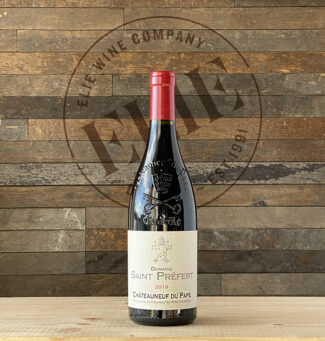
Domaine Saint Préfert, Châteauneuf-du-Pape ‘Classique’ 2019 ($53)
(Two Bottles)
With a base cuvée of 85% Grenache and 5% each of Syrah, Mourvèdre, and Cinsault, aged entirely in concrete tanks, is classic varietal choice as well as in name. Vinified from middle-aged vines—30 years old, tops—this wine is an expression of exuberance crammed with juicy raspberry and bright cherry and light hints of licorice. The sharp subcurrents of smoke and minerality provide a clue that these vines, and the wines they produce, will continue to improve with age.
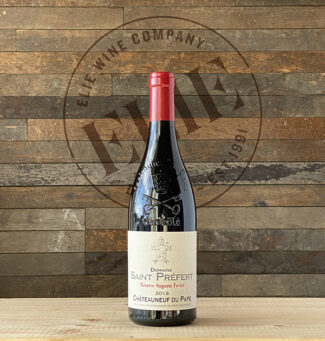 Domaine Saint Préfert, Châteauneuf-du-Pape ‘Réserve Auguste Favier’ 2019 ($82)
Domaine Saint Préfert, Châteauneuf-du-Pape ‘Réserve Auguste Favier’ 2019 ($82)
(One Bottle)
The eponymous August Favier was Isabel Ferrando’s maternal grandfather; the lieu-dit that produces this blend— 85% Grenache and 15% Cinsault—is also named for an original owner. Les Serres, a vineyard in the southernmost part of Châteauneuf-du-Pape, takes its name from Fernand Serre, who planted it in 1928. The grapes are hand-picked and vinified separately; the Grenache is aged in cement and the Cinsault in 600-liter barrels. Floral and exotic, the wine expresses a full-bodied core of blackberry draped with a lacy texture throughout, showing rich cassis and raspberry coulis flecked with the garrigue herbs that are native to the area. A long, elegant finish with a surprisingly silky tannic edge.
 Domaine Saint Préfert, Châteauneuf-du-Pape Blanc 2020 ($82)
Domaine Saint Préfert, Châteauneuf-du-Pape Blanc 2020 ($82)
(One Bottle)
This wine is a blend of 60% Clairette and 40% Roussanne, and is moderately acidic with a nose that displays honeysuckle, acacia flower and peach. The Roussanne lends a rich tannic structure while the Clairette offers minerality and the region’s characteristic salinity.
The Package …
This week’s package offering is comprised of the four wines featured above: Two of each of Côtes-du-Rhône and Châteauneuf-du-Pape ‘Classique’, and one of each of ‘Collection Charles Giraud’ and ‘Blanc’ for a total of six bottles at $329. The quantity of each included is, also, indicated in the write-up about the wine.
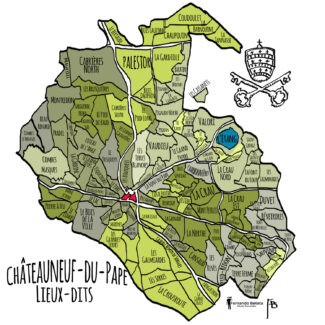
Also, from Domaine Saint Préfert
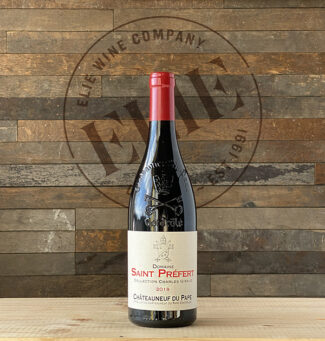 Domaine Saint Préfert, Châteauneuf-du-Pape ‘Collection Charles Giraud’ 2019 ($159)
Domaine Saint Préfert, Châteauneuf-du-Pape ‘Collection Charles Giraud’ 2019 ($159)
60% Grenache, 35% Mourvèdre and 5% Syrah, Isabel Ferrando’s ‘tête de cuvée’ is made from the oldest vines in two parcels—les Serres and le Cristia. The former features the famous, multipurpose galet stones of Châteauneuf that retain heat and night and protect the soil from erosion. Le Cristia is a sandy block with drainage ideal for Mourvèdre’s root system, which does not produce well otherwise. The wine shows concentrated boysenberry and violet pastille and candied fruit and bright, chewy back-end lift. As Auguste Favier was Isabel Ferrando’s maternal grandfather, Charles Giraud was her father’s father.
 Domaine Préfert (Isabel Ferrando), Châteauneuf-du-Pape ‘Colombis’ 2019 ($159)
Domaine Préfert (Isabel Ferrando), Châteauneuf-du-Pape ‘Colombis’ 2019 ($159)
Isabel Ferrando affixes her name to the mono-varietal wines she produces at Domaine Préfert. ‘Colombis’ is 100% Grenache, but a blend from three parcels in the western part of the appellation: Lieu-dit Colombis, featuring sandy soils, les Roues, where clay lies just beneath the surface, and le Cristia (not far from Château Rayas), where sand again predominates. The vines average 60 years-old and the concentrated juice from the small clusters produce a wine that critic Jeb Dunnuck referred to as “One of my favorite wines in the world.” Expansive in bouquet and again on the palate, the wine shows spice-accented currant preserves with incense and cola with crisp mineral undertones and an intensely long finish framed by velvety, well-integrated tannins.
The Exception in ‘Vin d’Exception’ : Pure Cinsault, Pure Audacity
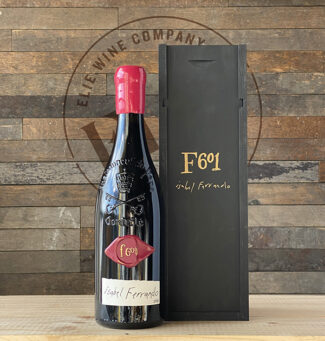 Domaine Préfert (Isabel Ferrando), Châteauneuf-du-Pape ‘F601’ 2018 ($850)
Domaine Préfert (Isabel Ferrando), Châteauneuf-du-Pape ‘F601’ 2018 ($850)
‘F601’ may sound like an unpoetic name for a lieu-dit, and in fact, it is an arid block in the southern part of the estate. It is also atypical of the terroirs of Châteauneuf-du-Pape; fifteen feet below the surface, sand made of degraded quartz can be found and a bit higher up, extra moisture is lodged in a fine layer of blue clay fed by the mica gravel and rolled pebbles already visible at ground level. Of this remarkable habitat for Cinsault Isabel Ferrando writes, “I needed 16 years of observation and apprenticeship to find the audacity to throw away the rule book and forge a personal relationship with this terror, guided by instinct and sensuality. With the 2018 vintage, I am launching ‘F601, and for the first time, the pure and absolute expression of the fusion between this block of land and the venerable Cinsault vines planted on it in 1928. At this defining moment in my life, I am happy to share with you my sense of wonder in this iconic Châteauneuf-du-Pape. Welcome to F601!”
Rich And Rare: White Châteauneuf-du-Pape en Magnum
 Domaine Saint Préfert, Châteauneuf-du-Pape Blanc 2020 ($189) – 1500 ml
Domaine Saint Préfert, Châteauneuf-du-Pape Blanc 2020 ($189) – 1500 ml
Before the wine, why the magnum? Surface area plays a tremendous role in the changes that a wine undergoes during élevage and later, ‘en bouteille’, and these changes happen at a rate that is in proportion to the size of the container. In a magnum—roughly twice the size of a conventional wine bottle—the aging process is slowed down and the wine will keep fresher longer; a plus if the wine is white. This wine is a blend of 60% Clairette and 40% Roussanne from the Serres lieu-dit, where galets, gravel and blue clay abound. It ages on lees for six months in large oak barrels, one third of which is new, one third year-old and the last third two year-old barrels. Moderately acidic, the nose shows honeysuckle, acacia flower and peach with the Roussanne lending a rich tannic structure and the Clairette offering minerality and the region’s characteristic salinity.
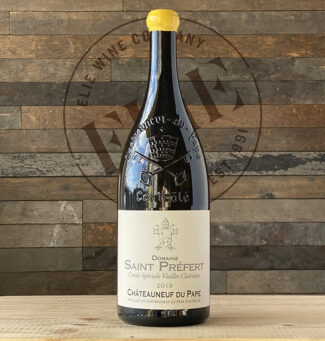 Domaine Saint Préfert, Châteauneuf-du-Pape Blanc ‘Cuvée Spéciale Vieilles Clairettes’ 2019 ($432) – 1500 ml
Domaine Saint Préfert, Châteauneuf-du-Pape Blanc ‘Cuvée Spéciale Vieilles Clairettes’ 2019 ($432) – 1500 ml
Only produced ‘en magnum’, this is a heavily allocated gem with less than a thousand bottles made and even fewer exported. 100% Clairette from 100-year-old vines in the dry-farmed lieu-dit ‘Quartier des Serre’ renowned for being one of the most sun-drenched plots in the appellation as well as nurturing vines in well-drained, river-rolled pebble soil. An exquisite, unctuous expression of an under-appreciated varietal, the wine reflects both sun and sand with warm notes of honey, quince jam, creamy lemon curd and pink grapefruit acidity as a backbone.
Notebook …
Vintage 2018
The quintessence of a year that the old winemaker’s cliché refers to ‘a vintage made in the vineyard’—based on the difficulty that growers had bringing in the harvest. Rains in May and June created a poor fruit set for Grenache, and the threat of mildew was redoubled by the failure of the mistral; a rare occurrence in Châteauneuf-du-Pape. Humidity skyrocketed, making 2018 the dampest year since 1973, and organic farmers grew frustrated that natural treatments were washed away by un-forecasted rain. The result was a harvest that in particular showed a 40%-60% reduction in Grenache. Syrah and Mourvèdre fared better, and these varieties tend to be more pronounced in the blends.
Vintage 2019
Grenache, however, enjoyed a marvelous renaissance in 2019, and for this sun, heat and wind-loving varietal, the vintage was ideal. An abundant fruit set was followed by three heat waves interspersed with rain and more moderate temperatures, and as a result, there was no heat stress for the vines, and ripening never shut down. Growers were able to pick at optimum ripeness and nothing much had to be done in the vineyard. The fruit’s health carried through to the cellar, with many growers reporting that their vinification were fast and efficient.
Vintage 2020
Following the extreme heat of 2019, growers were hoping for plenty of rainfall over the winter to replenish aquafers, and they got it. An astonishing 15 -20 inches of rain fell between October and December, and a mild early spring saw vine buds break nearly two weeks earlier than 2019. The summer was hot, but not unreasonably so; rains were moderate and frequent enough to prevent heat stress. Harvest for white grapes began in the third week of August, and the 2020 vintage is extremely strong in this category, however small (only 5% of Châteauneuf-du-Pape’s total). It is characterized by elegance and beauty, with a nose marked by citrus and stone fruit and a palate that combines balanced acidity with a prolonged finish.
RECENT ARRIVAL
A Question of Vintage
The vagaries of vintage are both a charm and a curse to winemakers, who routinely dream of abundance and quality. Most labels feature the vintage prominently, and serious wine people track and compare the results with other vintages. Vintage, of course, refers to the year in which the grapes were grown and is generally not the same year that the wine was bottled; vintage is as vital a piece of information as the name of the producer. In fact, there’s even a grading system: The Compagnie des Courtiers Jurés-Experts Piqueurs de Vins (The Guild of the Sworn Intermediary Wine Tasters) is a group of specialists that has existed for 700 years; in 1940, they began scoring wine based on a vintage chart, and today their much-sought-after, pocket-sized guide may be found online.
Lackluster harvests are particularly tough on monovarietal wines—wines made from a single type of grape, as is the case in much of Burgundy and the Loire. When a vigneron sets out to create an assemblage, however, in regions where AOP laws allow winemakers a certain leeway to portioning several varieties into a final blend, there is a unique set of decisions to be made. A given varietal may do better than another, and the percentage information—often listed on tech sheets but rarely on the bottle—become a source of knowledge as important as the vintage.
This week’s recent arrivals include selections from Châteauneuf-du-Pape in a difficult vintage, 2021. 18 different grapes are permitted under the Châteauneuf-du-Pape AOP regulations, and it is fair to say that some varieties fared better than others. This is where art of blending reaches its apogee, and where we find that the variance of vintage may create a number of unexpected masterpieces when winemakers are required to dig deeply into their tool-box to build a presentable product.
2021 was such a vintage, and as such, it has been referred to as ‘The Year of the Vigneron.’
Châteauneuf-du-Pape Vintage 2021
Year of The Vigneron
‘Precocious’ is a dangerously loaded word, whether it is used to describe a child or a vintage. It generally means that things are happening out of sequence, earlier than is usual. 2021 was such a season in Southern Rhône, and the rumbles of discontent began the year before. Autumn, 2020, was mild and damp and the season remained so until a short cold spell happened in January ʼ21. In February, Saharan winds brought unseasonable highs that reached into the mid-60s°F, advancing the vegetative cycle throughout the vineyards. Vines, if not growers, love these unseasonable warm spells, leaving them easy targets for one of a vigneron’s worst nightmares— spring frost. Sure enough, during the first week of April, a catastrophic frost lambasted the vineyards and across Châteauneuf-du-Pape, reports indicated potential losses of up to 80%. The double-whammy of frost is not only seen in the damage it inflicts at the time, but that it leaves grapes weaker and more susceptible to fungal disease in the weeks to come. To aggravate this latter risk, the rest of the spring was humid, with heavy rains accompanied by cooler temperatures and less than average sunshine, raising fears of coulure (uneven ripening).
In Châteauneuf-du-Pape, the catastrophe saw a 70% reduction in yield in a few spots, but overall, the impact was meliorated by the proximity of the Rhône River. Even so, in 2021, the skill of the winemaker came to the forefront. Every vigneron in the appellation had issues to deal with and questions to consider, including the use of whole bunch (weighing its aromatic benefits against the risk of underripe stalks), the amount of oak to use, how strictly to sort grapes, and in particular, how much to alter their blend in the varieties or vineyard plots they could draw from.
It is fair to say that the best domains did splendidly, creating wines in classical CdP style, meaning, possessed of exceptional elegance and incipient freshness, fruit not bogged down by alcohol. Managed well, cooler temperatures permit a long, slow ripening period and produce grapes with full phenolic ripeness but lower sugars. This leaves alcohol levels blissfully low compared to recent averages, and a welcome change to some of the headier wines of some vintages.
It can be argued that 2021 is not a vintage to cellar extensively, although the higher acid levels still work in favor of longevity. Perhaps this is a vintage to enjoy young, and to celebrate the Year of the Vigneron with tonight’s meal.
Domaine Charvin
Among Laurent Charvin’s several ‘claims to fame’ is the fact that up until recently, he was the only producer in Châteauneuf-du-Pape to vinify traditionally, using whole-cluster fermentation and to élevage in concrete (rather than oak) for 21 months prior to bottling. Working with about 25 acres within that hallowed appellation, he is known for producing elegant and CdPs that check all the boxes for the ideal balance between finesse and power.
Also somewhat unique to Charvin is the sharply acidic little grape Vaccarèse, which makes up about 5% of his blends. It’s a variety well-suited to his particular terroir, which is somewhat sandier than many and helps define his cuvées by lending more perfume, minerality and elegance.
Says Charvin: “Our main concern is always our work in the vineyards. In the cellar, it is surprisingly easy to spoil the harvest and not repair very much. In our favor is our old vines, averaging 60 years, and our approach to farming; these vineyards have been certified ‘agriculture biologique’ since 2014.”
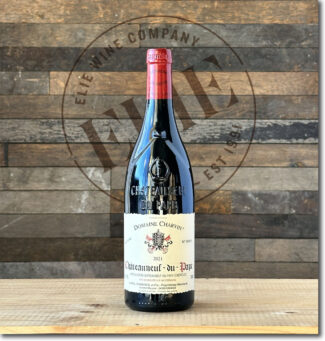 Domaine Charvin, 2021 Châteauneuf-du-Pape ($73)
Domaine Charvin, 2021 Châteauneuf-du-Pape ($73)
82% Grenache, with the balance divided between Mourvèdre, Vaccarèse, Syrah and Counoise. In the 2021 vintage, production was down 40%, meaning there is not much to go around, but the bottles we scored shows a wine with luscious aromas of forest fruit—raspberry, blueberry and wild strawberry—woven into a rose-petal core. On the palate it is distinctively elegant and telegraphs freshness rather than weight, with a lot of peppery fruit that stays in focus through the finish. It’s fine to drink immediately (given a little time to breathe) but should store well for at least another decade.
Domaine de Ferrand
Philippe Bravay is a winemaker who makes mountains of molehills: Domaine de Ferrand covers a lilliputian 17 acres in Châteauneuf-du-Pape vineyards spread over six parcels in four lieux-dits. Half of his vines are 45 years old and the rest are 95 to 110. In order to maximize the potential available to him, Bravay relies upon organic growing techniques and limits yields strictly.
Philippe’s vinification philosophy and practice is the same for all his wines: “I do not use barriques because I want the wine of my vines and not a technical élevage which loses the origins of the wine. There is no filtration, only one fining for each wine. During the aging, the wine is neither racked nor blended, which is done only at the time of bottling and without the addition of preservatives.”
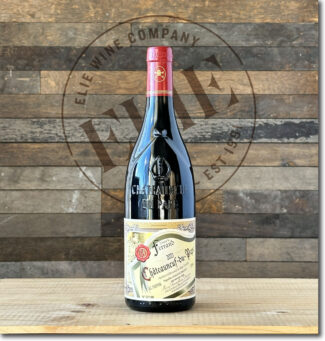 Domaine de Ferrand, 2021 Châteauneuf-du-Pape ($63)
Domaine de Ferrand, 2021 Châteauneuf-du-Pape ($63)
90% Grenache; 10% field blend. The wine exudes the sensuous, savory delicacy of a young, old-school CdP, with crushed violet on the nose with juicy cherry, raspberry and strawberry defining the fruit and a ferrous note of crushed rocks, garrigue and white pepper shoring up the herbal and mineral face of the profile.
Chapelle St. Théodoric
Chapelle St. Théodoric may be an odd egg, but it’s Fabergé-egg odd. For starters, it’s new—its first vintage was 2009 and it produces only 100% Grenache cuvées. Even its name is a bit of a misnomer, since it has nothing to do with Chapelle St. Théodoric, a thousand-year-old chapel that sits in the center of Châteauneuf-du-Pape at Avenue Baron le Roy.
Instead, the winery is the brainchild of two wine authorities, Domaine de Cristia owner Baptiste Grangeon and American wine importer Peter Weygandt. Their goal was to show the different expression of old-vine Grenache grown in two similar, but unique lieux-dits—Guigasse and Pignan. These areas boast sandy soils nearly stone-free and contain only Grenache vines with an average age of 50 years; some vines are more than a hundred.
The vines are overseen using biodynamic principles and the wine made by the team at Domaine de Cristia.
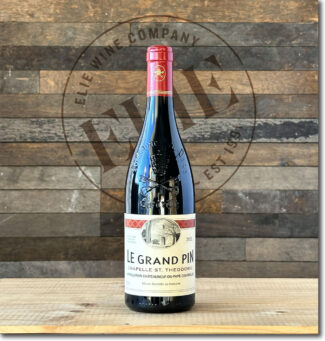 Chapelle St. Théodoric ‘Le Grand Pin’, 2021 Châteauneuf-du-Pape ($108)
Chapelle St. Théodoric ‘Le Grand Pin’, 2021 Châteauneuf-du-Pape ($108)
From 35-year-old vines in the Pignan lieu-dit, vinified as whole clusters and then aged 24 months in older demi-muids. This 100% Grenache is ruby-hued and offers a nuanced bouquet of mulled red and black fruits, cured meats, spring flowers, and ground pepper. The Northern-Rhône-like gaminess is flanked by mineral, chalky notes and a touch of pine sap at the finish.
 Chapelle St. Théodoric ‘La Guigasse’, 2021 Châteauneuf-du-Pape ($99)
Chapelle St. Théodoric ‘La Guigasse’, 2021 Châteauneuf-du-Pape ($99)
From 75-year-old Grenache grown in the sandy soils of Guigasse; the wine was fermented as whole clusters and spent two years in older demi-muids. Newly released, it demonstrates an intriguing spiciness on the nose, with herbal notes to provide a compelling counterpoint to the cherry and raspberry. Considered by some to be ‘the wine of the vintage.’
Domaine Raymond Usseglio
The Usseglio clan, with wine roots in Italy even before the patron Francis moved to Rhône in 1931, produce (under several domain names) some of the best Châteauneuf-du-Pape on the market. So many labels in the region bear the Usseglio name that it is a chore to keep them separate.
Raymond, one of two winemaking sons of Francis, created this estate in 1964 and began producing wine under his own name immediately, a somewhat rare practice in the era. Of the domain’s 45 acres of vines in CdP, eight are used for white wines, the rest devoted to red. These vines are beautifully situated in two locations, half in the famous La Crau vineyard, with the remaining vines situated close to the ancient castle of the Pope in the lieux-dits l’Arnesque, Bois Senechaux, Cabrières, Carbonnières, Palestor, les Terres Blanches and le Tresquoys.
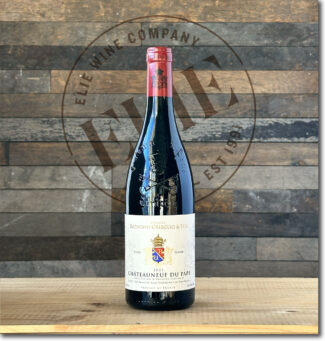 Domaine Raymond Usseglio ‘Cuvée Girard’, 2021 Châteauneuf-du-Pape ($49)
Domaine Raymond Usseglio ‘Cuvée Girard’, 2021 Châteauneuf-du-Pape ($49)
Due to the weather throughout the growing season, Raymond used a higher proportion of old vine fruit in his entry-level cuvée, giving weight and velvety richness to the blend. Mostly Grenache with a balance of Mourvèdre, Counoise and tiny amounts of Syrah and Cinsault, all underwent whole cluster fermentation. The vines are from several areas in Châteauneuf, but predominantly Les Terres Blanches, Bois Senechaux and La Crau, all north to east of the village itself. 10% of the Girard is from 120-year-old vines, and all varieties are concrete-aged except for the Mourvèdre, which is aged in barrique and blended at the final assemblage. The wine is a fragrant spice box, with ripe black cherry, mint and a pinch of white pepper.
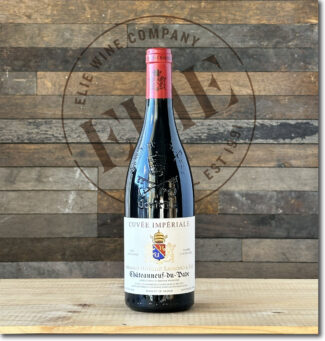 Domaine Raymond Usseglio ‘Cuvée Impériale – Vignes Centenaires’, 2021 Châteauneuf-du-Pape ($87)
Domaine Raymond Usseglio ‘Cuvée Impériale – Vignes Centenaires’, 2021 Châteauneuf-du-Pape ($87)
From old vines grown in two sandy parcels, Pied-Long (sand on red clay and galets roulés) and one in the more famous la Crau. For various reasons (some unexplainable), fruit from Pied-Long ripens about two weeks later than La Crau, giving it an immediate advantage, as a slow ripening process allows grapes to gain in complexity. The wine shows exotic aromas of orange zest, Campari-like spice and exquisitely ripe cherries while the full-bodied palate is silky in texture remaining airy and vibrant through a long, zesty finish.
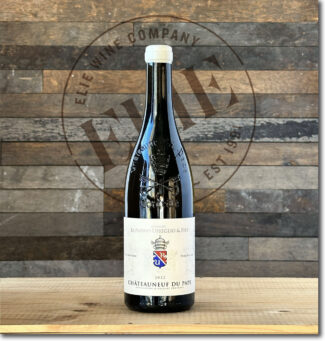 Domaine Raymond Usseglio ‘Pure Roussane’, 2022 Châteauneuf-du-Pape Blanc ($68)
Domaine Raymond Usseglio ‘Pure Roussane’, 2022 Châteauneuf-du-Pape Blanc ($68)
100% Roussanne, a grape with naturally low yields. Usseglio has planted these vines partly on sandy soils and partly in a terroir where clay and loam are interspersed with the area’s famous galets. The combination of terroirs produces a wine with all depth and finesse and a concentrated Roussanne profile: Quince and linden flowers on the nose, and on the palate, lemon and orange zest, green herbs and ripe apricot perfectly balanced with an elegant acidity on a long finish.
- - -
Posted on 2024.01.20 in Châteauneuf-du-Pape, France, Wine-Aid Packages, Southern Rhone | Read more...
Featured Wines
- Notebook: A’Boudt Town
- Saturday Sips Wines
- Saturday Sips Review Club
- The Champagne Society
- Wine-Aid Packages
Wine Regions
Grape Varieties
Aglianico, Albarino, Albarín Tinto, Albillo, Alicante Bouschet, Aligote, Altesse, Arbanne, Arcos, Auxerrois, Barbarossa, Beaune, Biancu Gentile, Bonarda, bourboulenc, Cabernet Sauvignon, Caladoc, Calvi, Carignan, Chablis, Chenin Blanc, Cinsault, Clairette, Cortese, Corvinone, Cot, Counoise, Dolcetto, Fiano, folle Blanche, Frappato, Fumin, Gamay, Garganega, Garnacha Tintorera, Godello, Graciano, Grenache, Grenache Blanc, Grolleau, Groppello, Jacquère, Juan Garcia, Lladoner Pelut, Macabeo, Maconnais, Malbec, Malvasia, Malvasia Nera, manseng, Marcelan, Marselan, Marzemino, Melon de Bourgogne, Mencía, Merlot, Montepulciano, Montònega, Mourv, Mourvèdre, Muscadelle, Muscat, Natural, Nebbiolo, Nero d'Avola, Niellucciu, Palomino, Patrimonio, Pecorino, Pedro Ximénez, Persan, Pineau d'Aunis, Pinot Auxerrois, Pinot Gris, Pinot Meunier, Pouilly Fuisse, Pouilly Loche, Poulsard, Riesling, Rose, Rousanne, Sagrantino, Sangiovese, Sauvignon, Sciacarellu, Serine, Souson, Sumoll, Tempranillo, Teroldego, Timorasso, Trebbiano Valtenesi, Treixadura, trepat, Trousseau, Ugni Blanc, Vermentino, Viognier, Viura, Xarel-loWines & Events by Date
- September 2025
- August 2025
- July 2025
- June 2025
- May 2025
- April 2025
- March 2025
- February 2025
- January 2025
- December 2024
- November 2024
- October 2024
- September 2024
- August 2024
- July 2024
- June 2024
- May 2024
- April 2024
- March 2024
- February 2024
- January 2024
- December 2023
- November 2023
- October 2023
- September 2023
- August 2023
- July 2023
- June 2023
- May 2023
- April 2023
- March 2023
- February 2023
- January 2023
- December 2022
- November 2022
- October 2022
- September 2022
- August 2022
- July 2022
- June 2022
- May 2022
- April 2022
- March 2022
- February 2022
- January 2022
- December 2021
- November 2021
- October 2021
- September 2021
- August 2021
- July 2021
- June 2021
- May 2021
- April 2021
- March 2021
- February 2021
- January 2021
- December 2020
- November 2020
- October 2020
- September 2020
- August 2020
- July 2020
- June 2020
- May 2020
- April 2020
- March 2020
- February 2020
- January 2020
- December 2019
- November 2019
- October 2019
- September 2019
- August 2019
- July 2019
- June 2019
- May 2019
- April 2019
- March 2019
- February 2019
- January 2019
- December 2018
- November 2018
- October 2018
- September 2018
- August 2018
- July 2018
- June 2018
- May 2018
- April 2018
- March 2018
- February 2018
- January 2018
- December 2017
- November 2017
- October 2017
- September 2017
- August 2017
- July 2017
- June 2017
- May 2017
- April 2017
- March 2017
- February 2017
- January 2017
- December 2016
- November 2016
- October 2016
- September 2016
- August 2016
- July 2016
- June 2016
- May 2016
- April 2016
- March 2016
- February 2016
- January 2016
- December 2015
- November 2015
- October 2015
- September 2015
- August 2015
- July 2015
- June 2015
- May 2015
- April 2015
- March 2015
- February 2015
- January 2015
- December 2014
- November 2014
- October 2014
- September 2014
- August 2014
- July 2014
- June 2014
- April 2014
- March 2014
- February 2014
- January 2014
- December 2013
- November 2013
- October 2013
- September 2013
- August 2013
- July 2013
- June 2013
- May 2013
- April 2013
- March 2013
- February 2013
- January 2013
- December 2012
- November 2012
- October 2012

